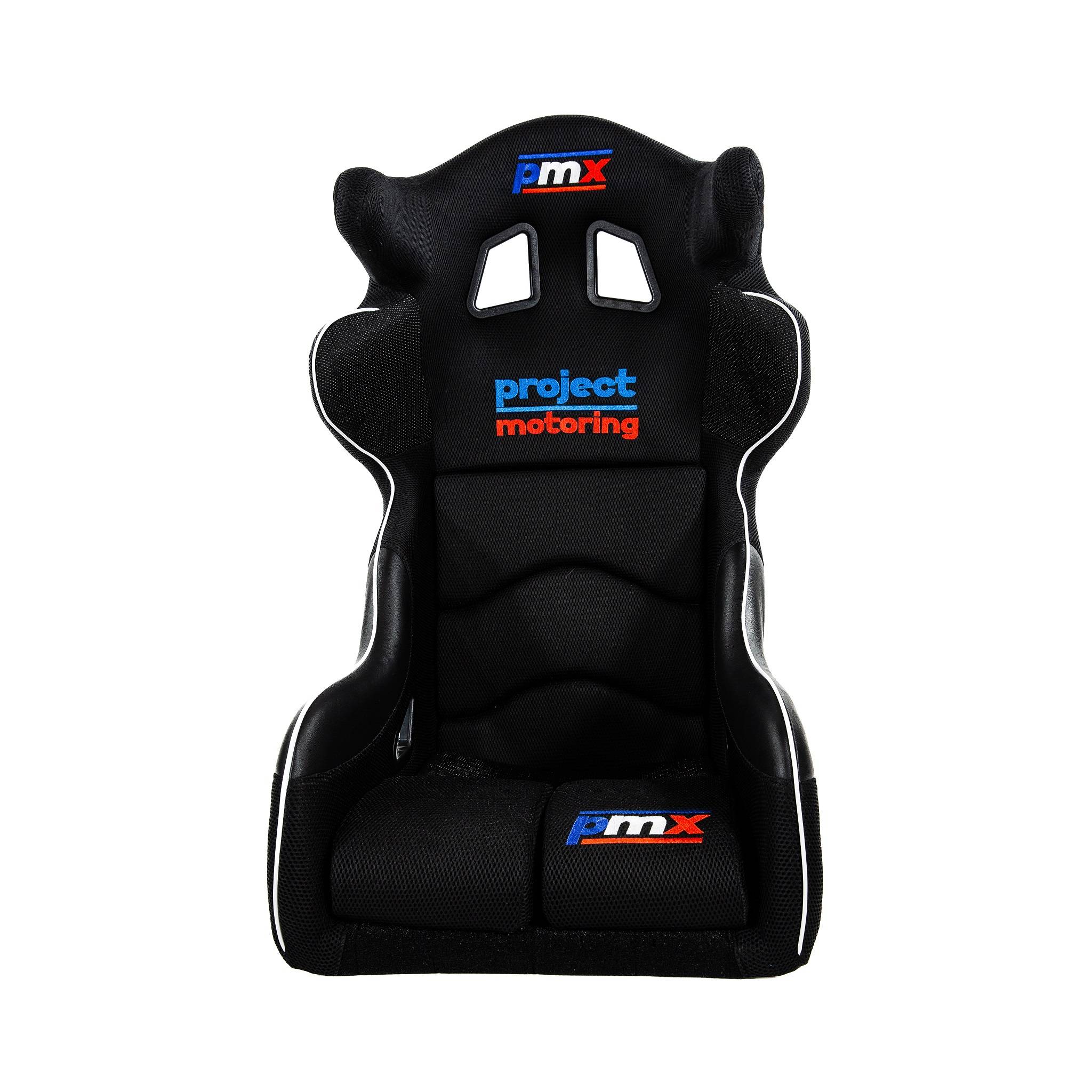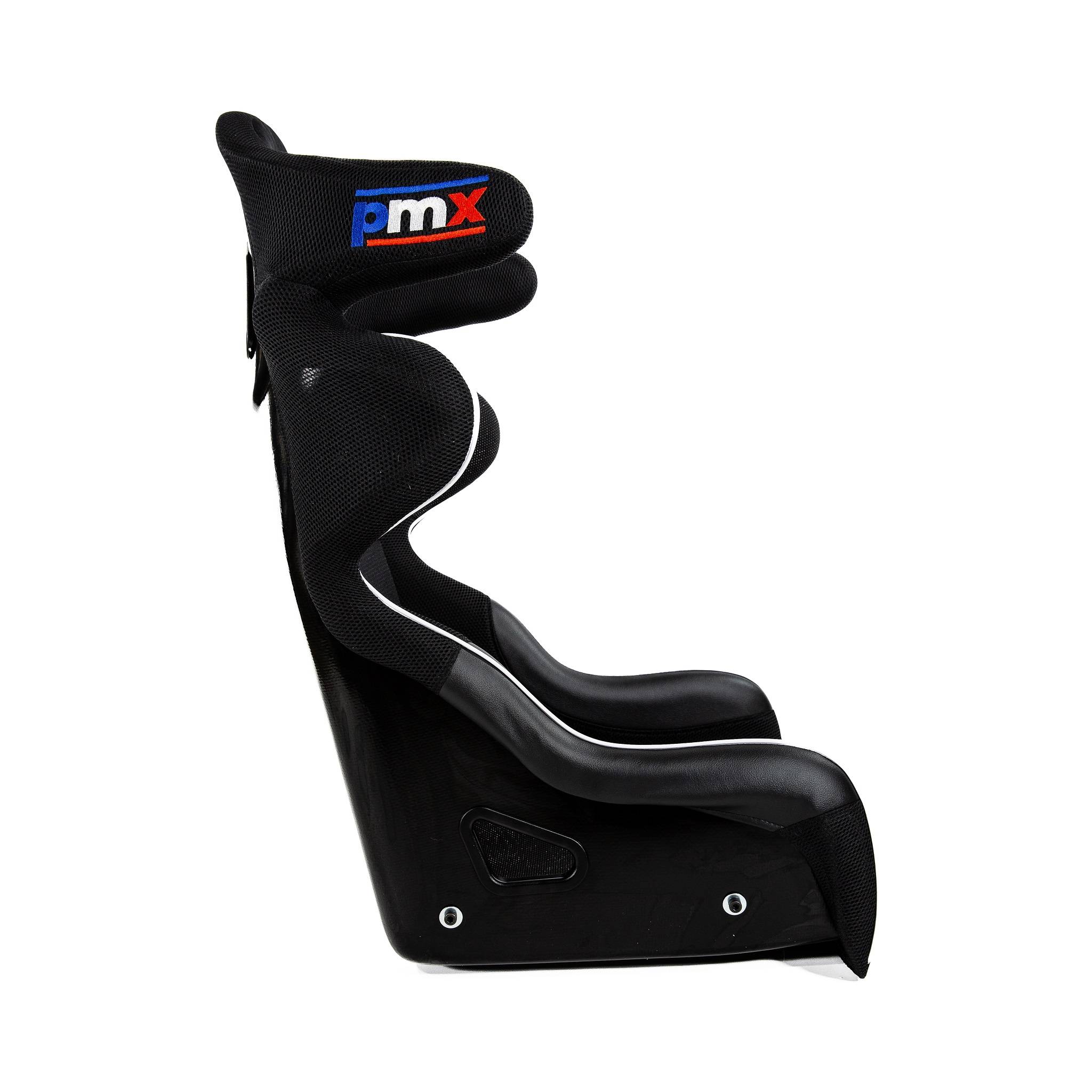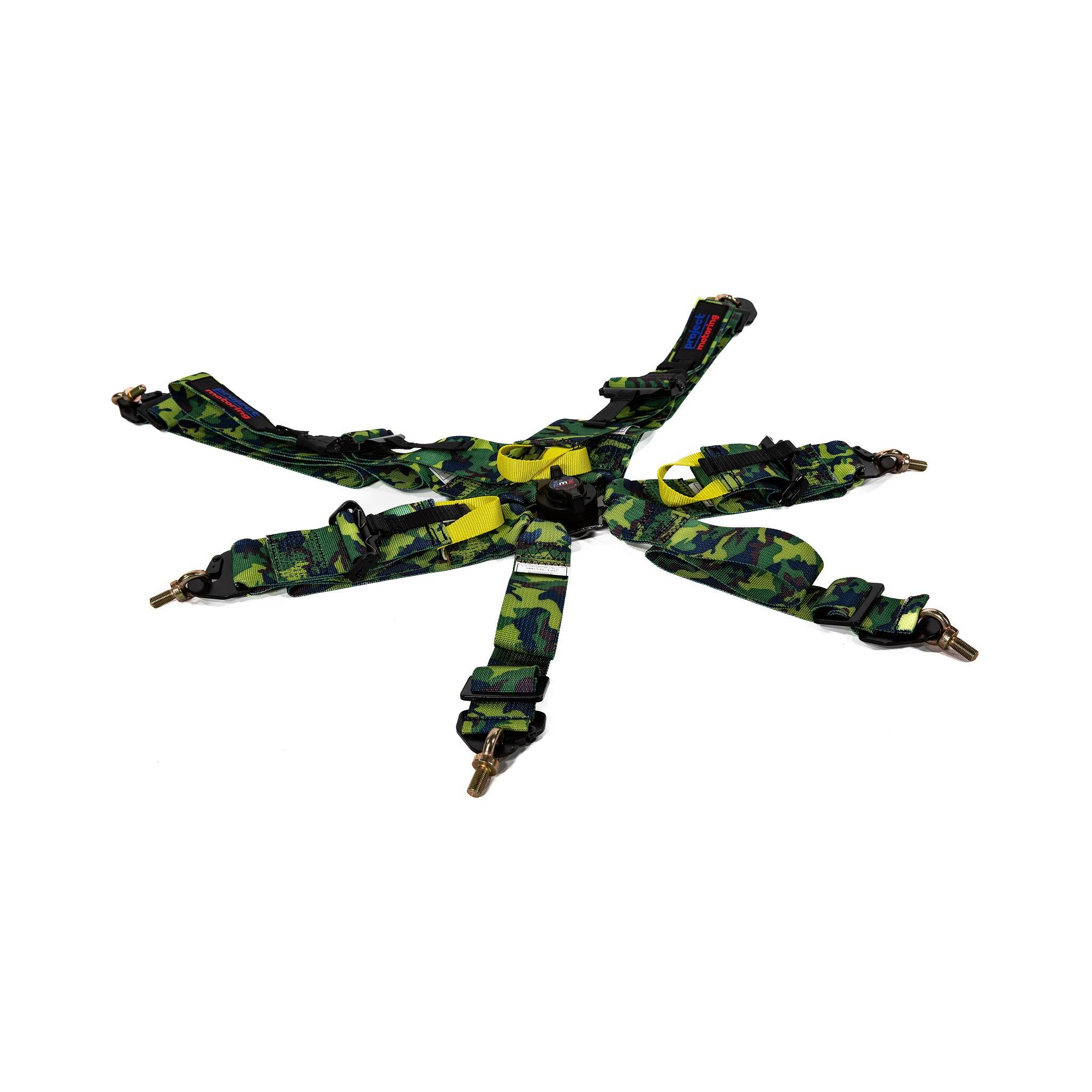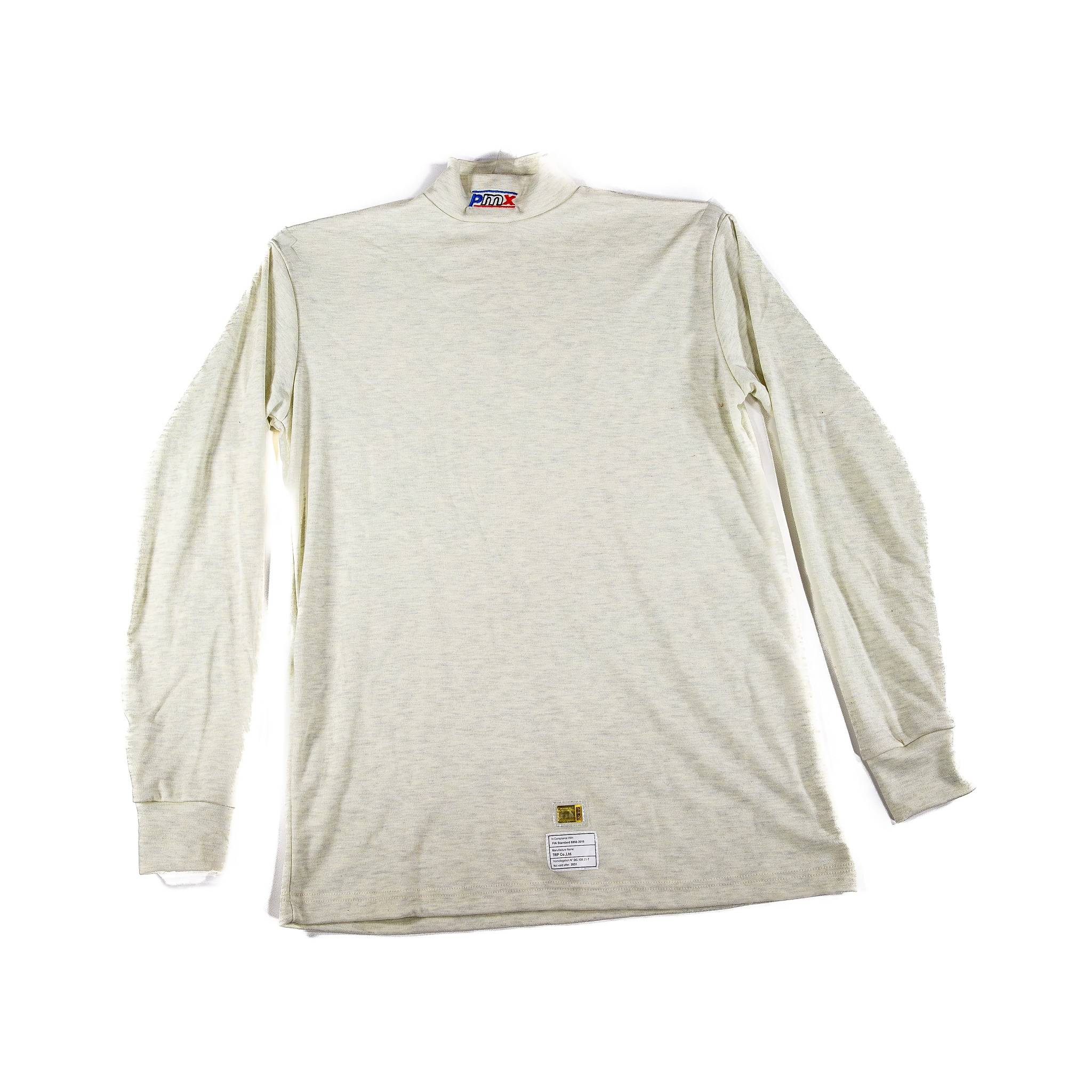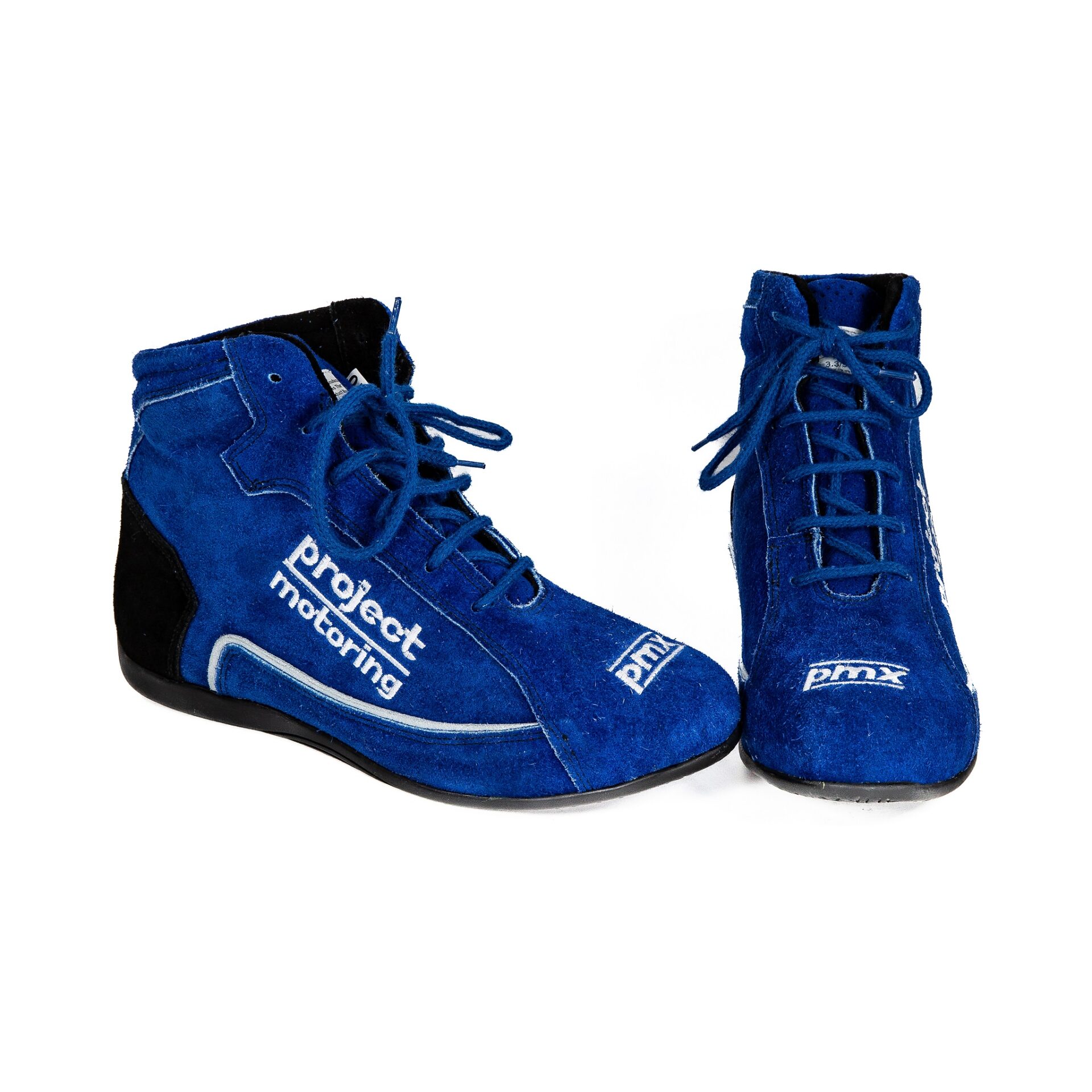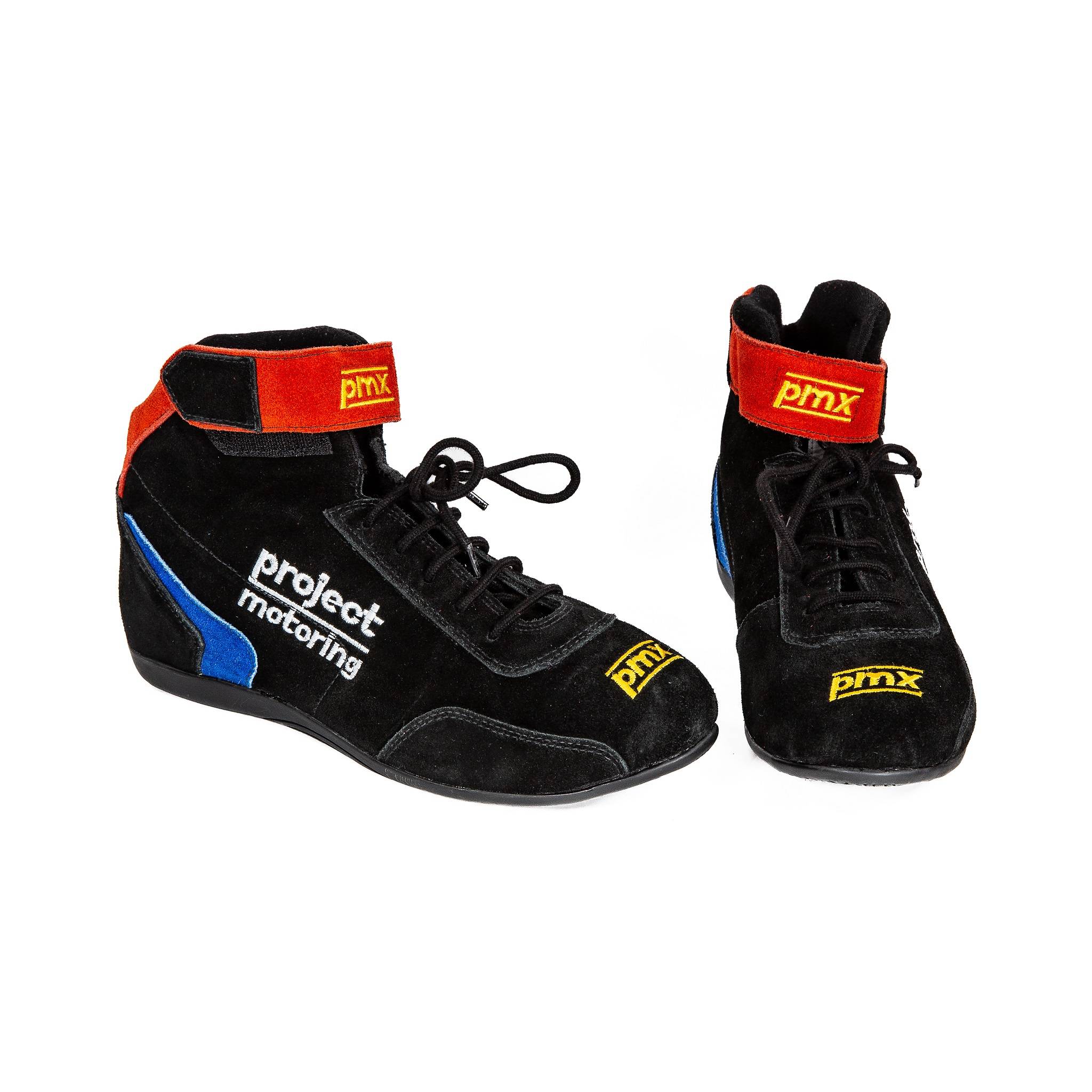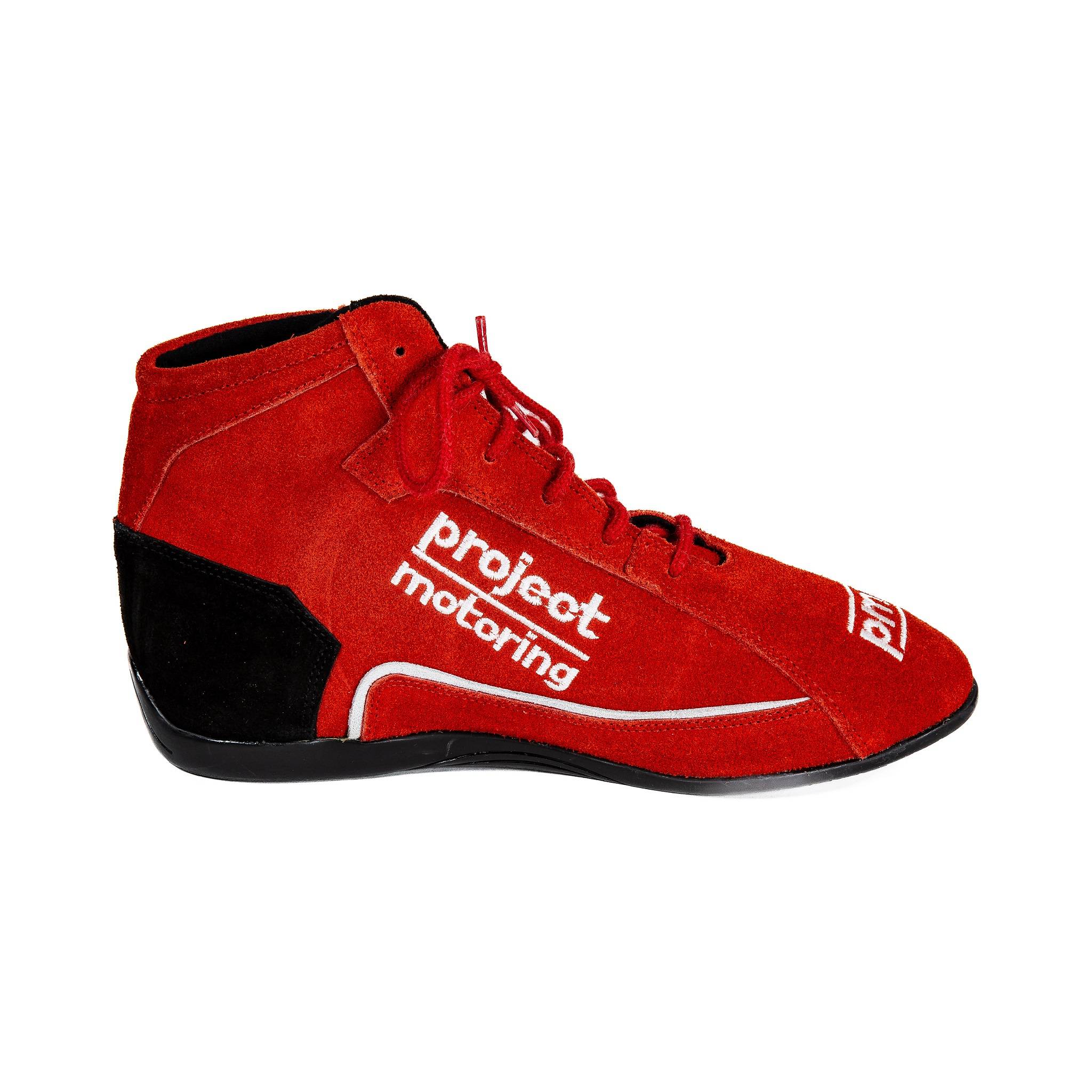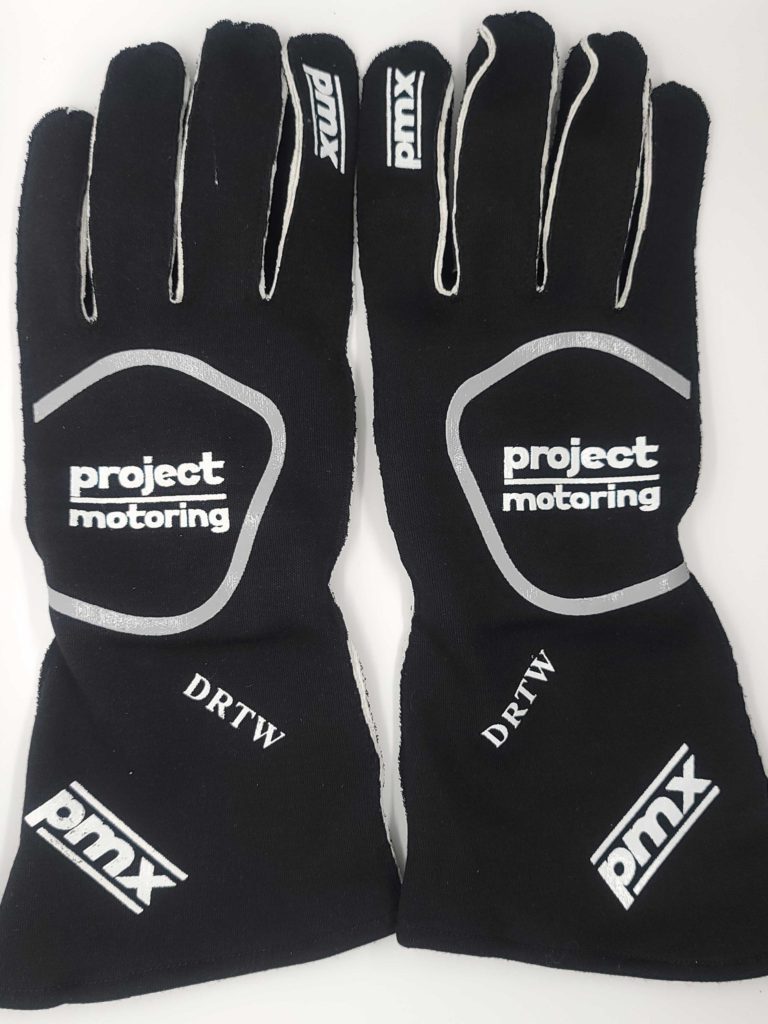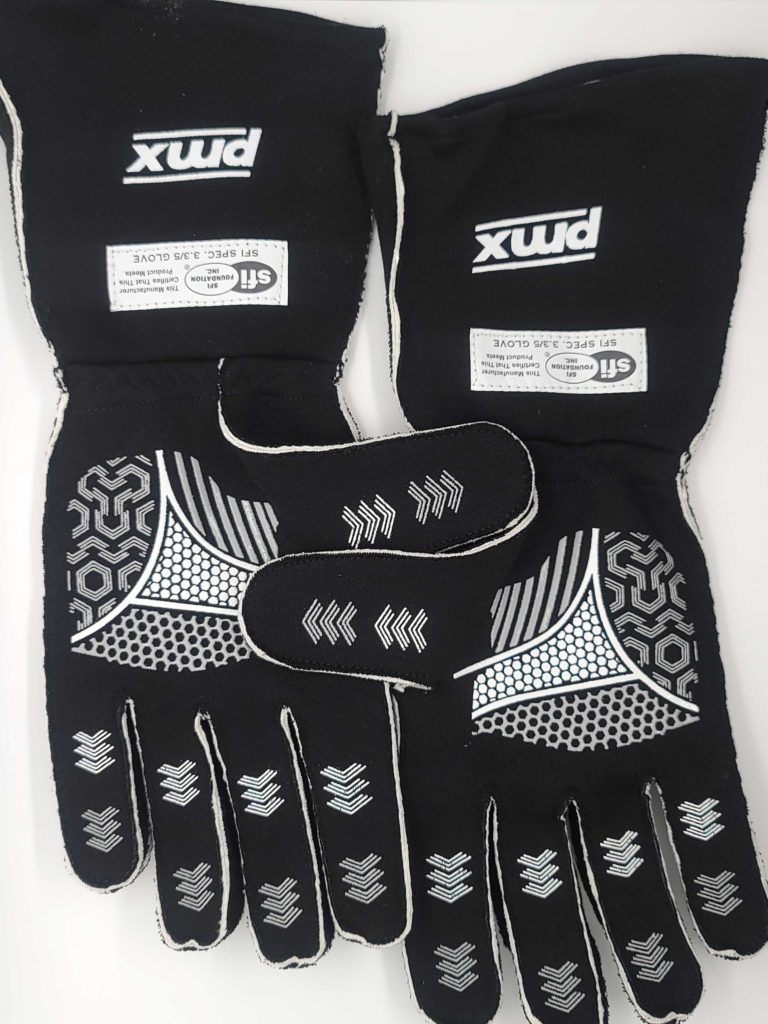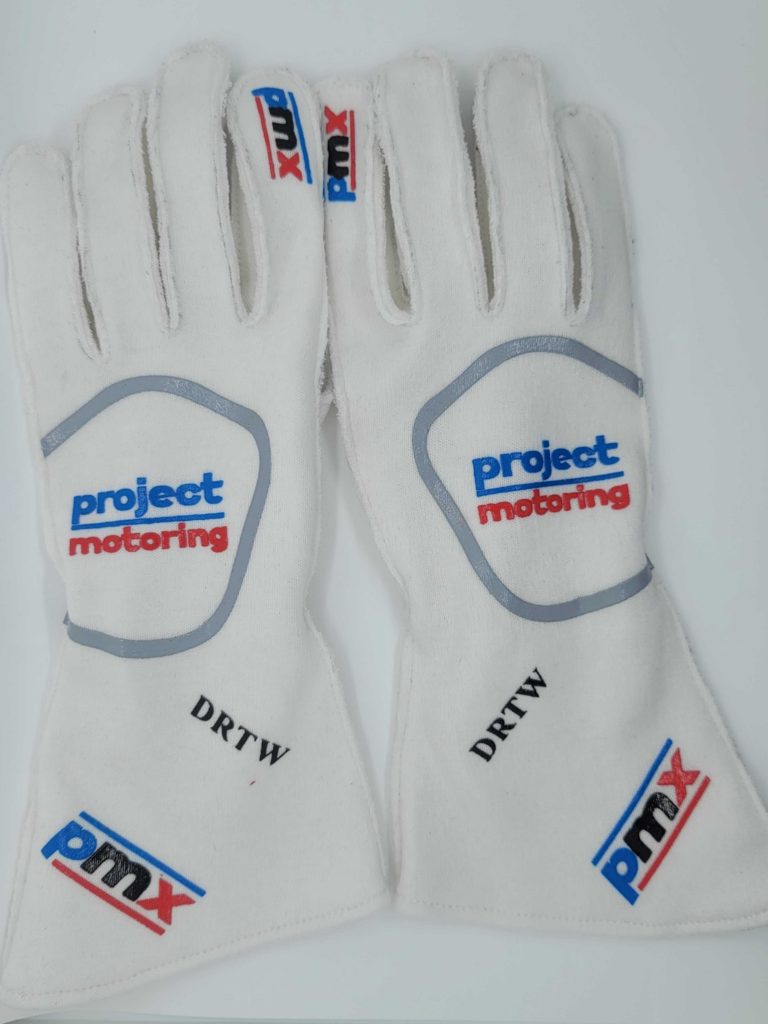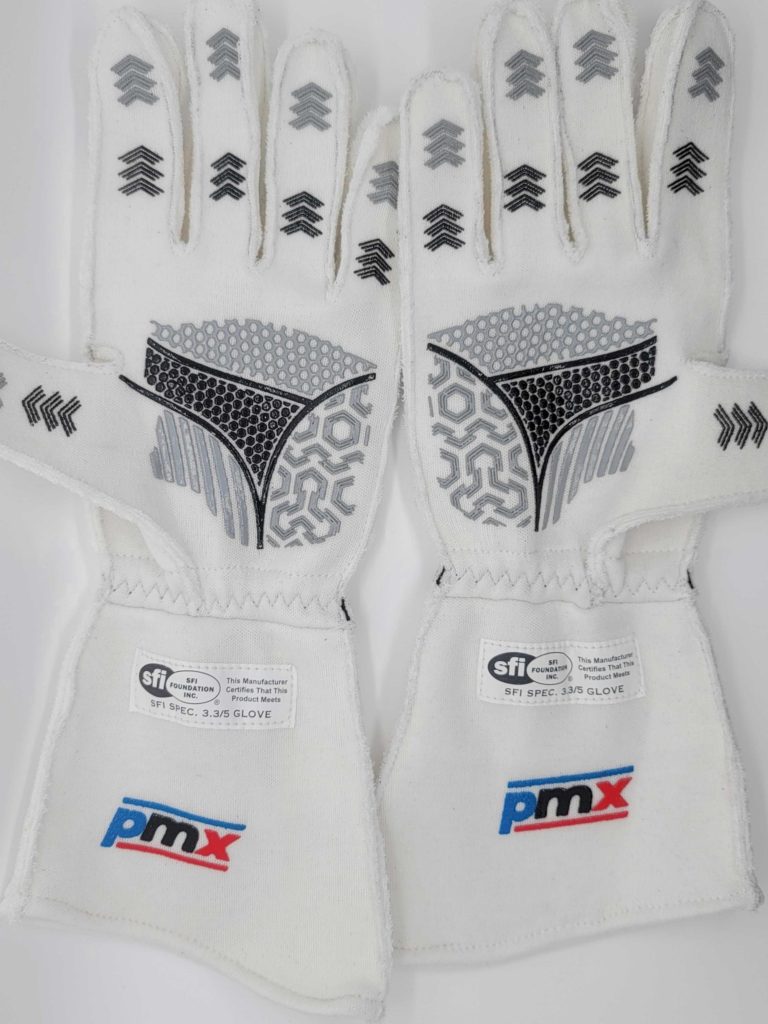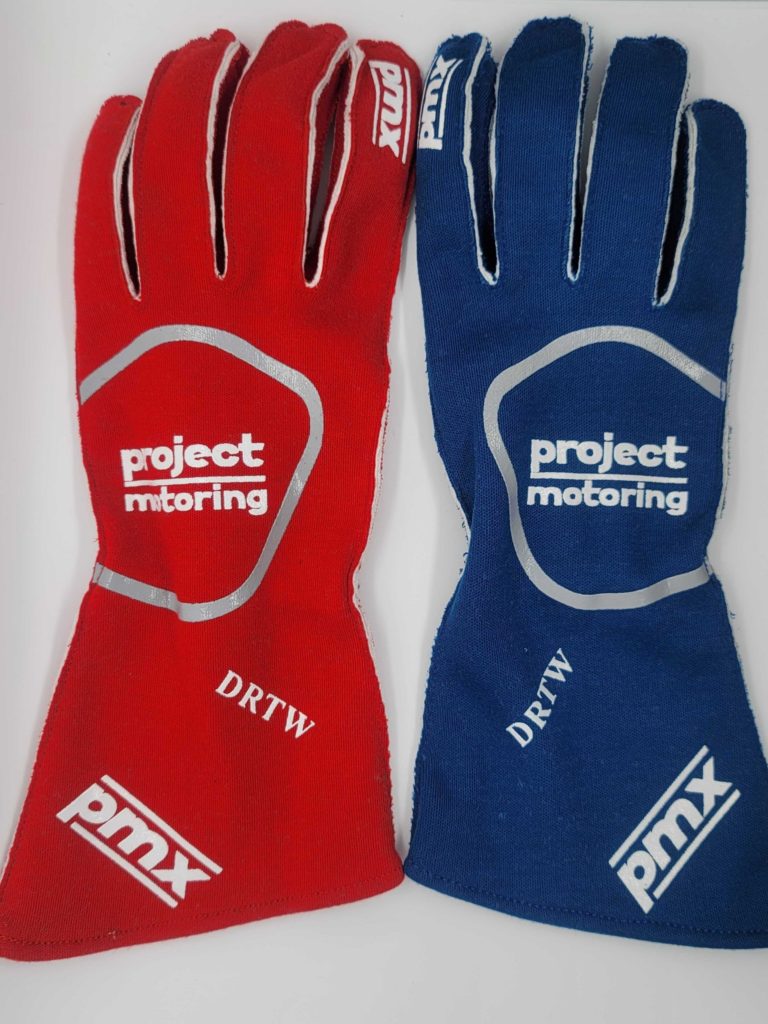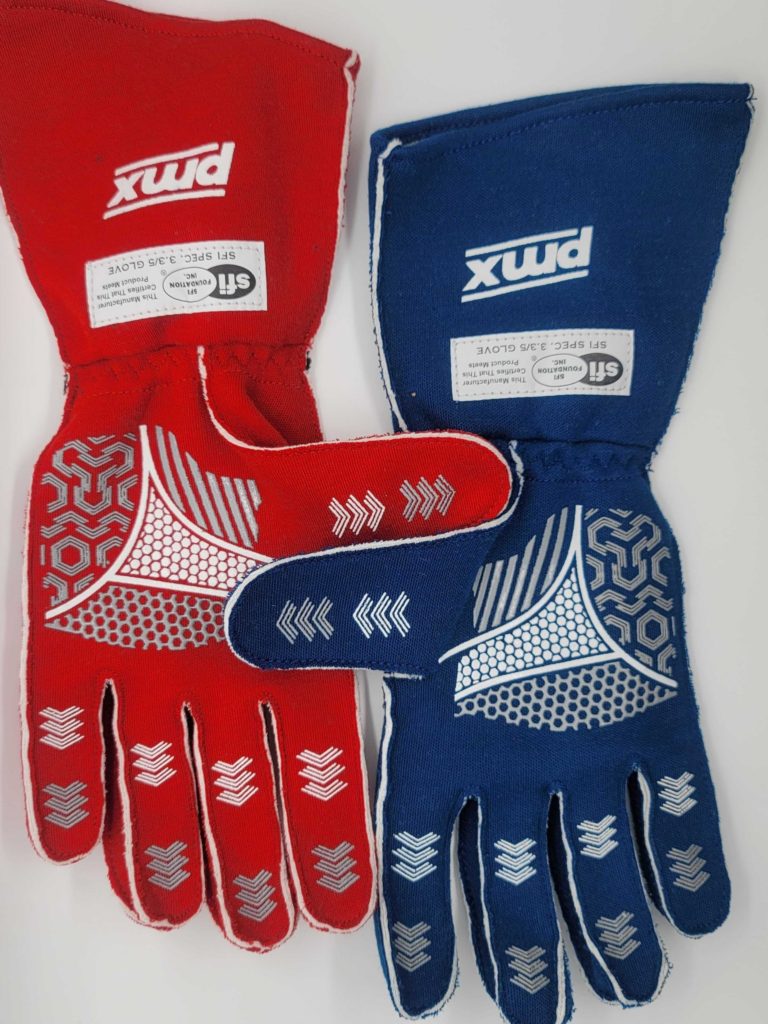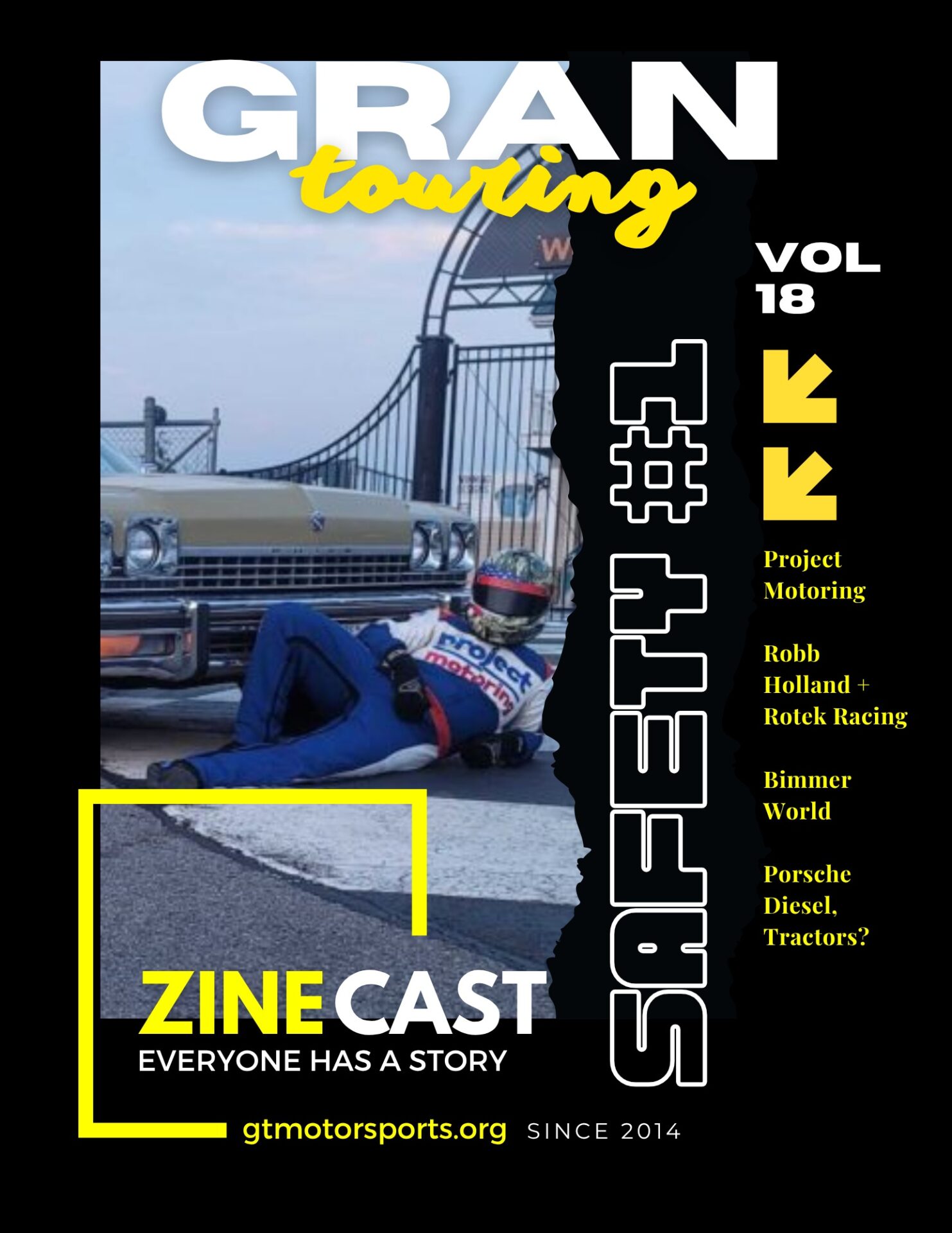A veteran owned company born from a passion for fire safety, Project Motoring, sells it’s own line of American designed racing safety equipment and apparel (PMX), as well as other well known name brands. We offer a variety of quality products to include helmets, helmet shields, intercoms, custom tailored racing suits, racing gloves, racing shoes, seat belts, racing seats, and many more items.
A long time car nut – John R. Caffese, Esq – Founder & CEO of Project Motoring – whose passion for being on track has evolved into trying to make it safe and accessible for everyone. An Attorney, Army Officer, and Volunteer Firefighter off the track, he is a safety steward and MSF level 2 certified instructor with several organizations on the track. This passion for fire safety has expanded to all types of racing equipment, resulting in the formation of Project Motoring.
Tune in everywhere you stream, download or listen!
 |  |  |
- Spotlight
- Notes
- Transcript
- Highlights
- Learn More
Spotlight
John R. Caffese. Esq - Founder & CEO for Project Motoring (PMX)
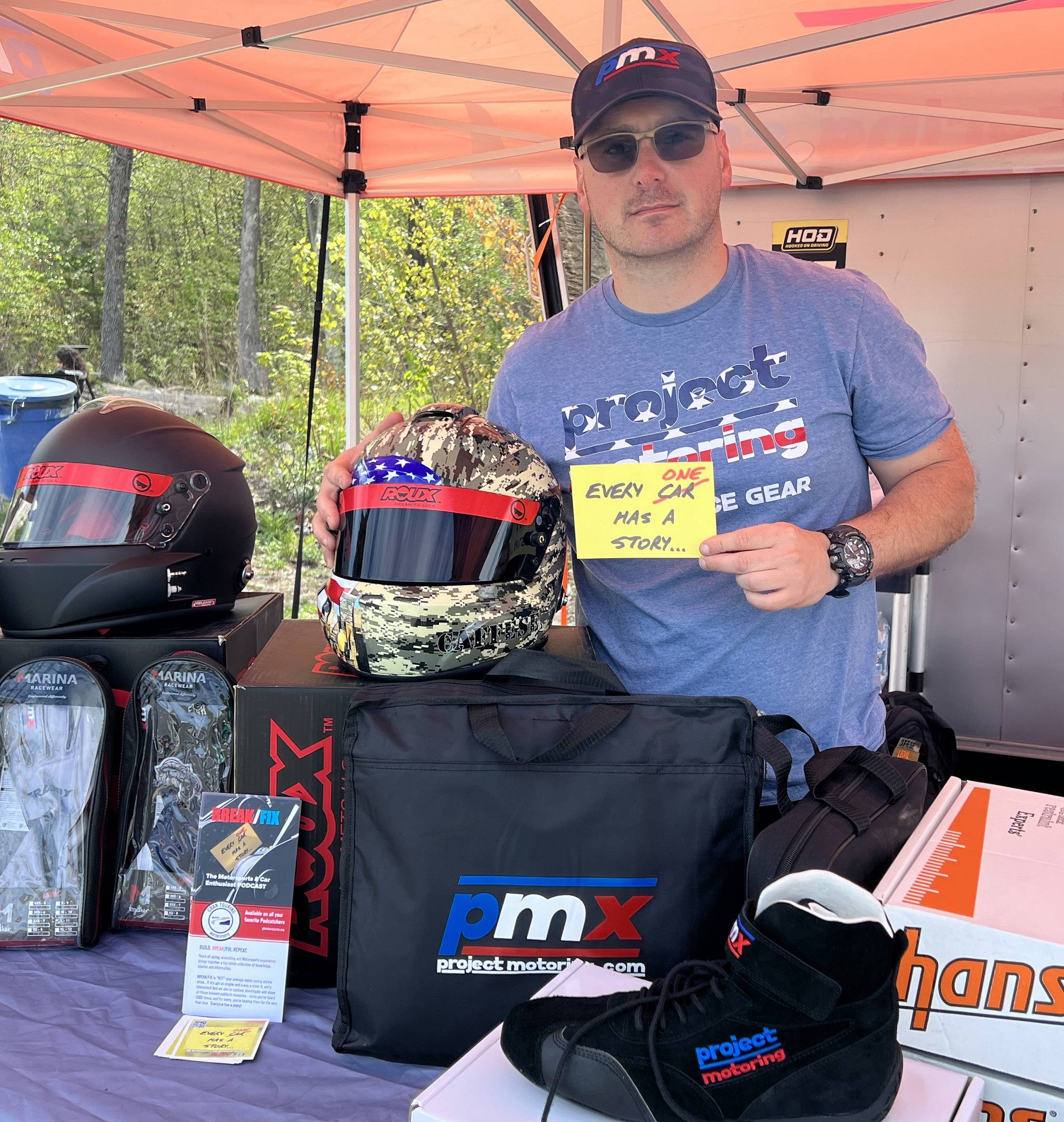
American designed racing quality safety equipment & apparel, by a veteran owned company.
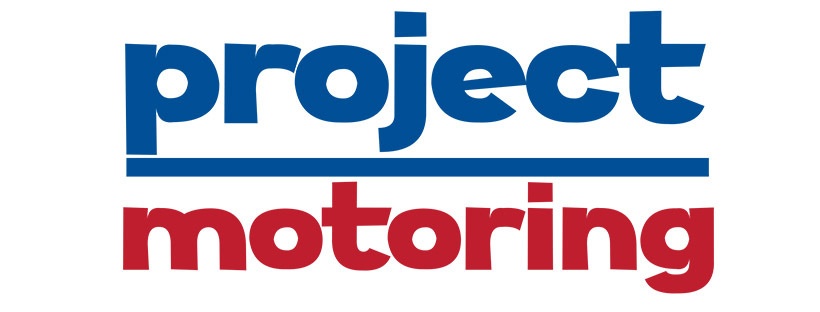
Contact: John R. Caffese. Esq at john@projectmotoring.com | N/A | Visit Online!![]()
![]()
![]()
Notes
- Origin Story of Project Motoring – what inspired the brand?
- Race Suits, Shoes, Gloves and more!
- Technical discussion about Nomex Testing, SFI & FIA
- Heat Resistance & Flame Retardant – what does that even mean?
- What is the plan for Project Motoring in 2022 and beyond?
and much, much more!
Transcript
Crew Chief Brad: [00:00:00] Break fix podcast is all about capturing the living history of people from all over the auto sphere, from wrench turners and racers to artists, authors, designers, and everything in between. Our goal is to inspire a new generation of petrol heads that wonder. How did they get that job or become that person?
The road to success is paved by all of us because everyone has a story.
Crew Chief Eric: Hey everybody, crew chief, Eric here. And I know it’s been a while since we’ve had tonight’s guest on our show. And a little known fact, he was actually on our very first recording, although it didn’t come out until way later in season one.
So with me tonight is John Caffese, who has now resurfaced from being away for quite a while. And he wants to share. A long term project he’s been working on called The Project. So John, welcome back to Break Fix. We’re going to dive in a little deeper [00:01:00] into what The Project is all about, how it started, and where it’s going.
John Caffese: Hello, hello. Excited to be back. Yes, I remember episode one about another topic that was a brainchild of ours. So excited to be back and talk about The Project. Old things and new things. That’s right. Last time
Crew Chief Eric: you were on, we were talking about what should I buy V8 convertibles.
John Caffese: Mm hmm. Mm hmm. And it was a good time.
Unfortunately, we weren’t, I would say, prepared as we would be normally, in a good way, in the fact that independently, I believe, the three or four of us all came up with about the same list of six cars. Yeah. And we’re like, well, this is a problem, because we’re all saying the same thing. Our spidey senses were working pretty well.
We should have checked with each other to see, Hey, I’m going to say this car, okay, so I shouldn’t, so.
Crew Chief Eric: But you know, I have to thank you for setting off our first What Should I Buy, because it has been a popular and reoccurring set of episodes in our series, and we’ve done several since then.
John Caffese: I’m a trendsetter.
I feel like we’ve started a lot of fads, both in the [00:02:00] GTM community and abroad. I will take all the credit for it single handedly, despite all your hard work over the last year. Thank you. I appreciate you running the torch. I would like to give you some house points, which I also created and introduced. So points to you and uh, let’s have a good time.
Crew Chief Eric: Well, as we sit back in our smoking jackets, leather bound books and chairs in the cigar club here, sipping on, what are we, what are we drinking? We have only of the
John Caffese: finest. liqueur, uh, Di Serrano. That’s right. And uh, and cheers. Cheers. Welcome back. Mixed with a small family recipe. of Sugary Syrup. You may have heard of it.
Out of the Atlanta area. Out of Atlanta. Coca Cola. No sponsorship or endorsement implied. But, uh
Crew Chief Eric: So let’s take a trip down memory lane. Let’s talk about The Project. Or The Project Motoring, I guess. Officially referred to as.
John Caffese: Sure. So project motoring today is a safety apparel company that we’ve started. We being me and Dave [00:03:00] Gilbert, another instructor coach driver with us.
If you guys know a little bit about me, great. If you don’t MSF level two certified. Instructor. I was a regional owner and now staff member of Hooked on Driving Northeast. I work with the corporate a lot. We’re pretty national in that. SCCA instructor. You name it. I’ve been in other organizations. Been doing HPDEs and the behind the scenes business of HPDEs for almost a decade.
It’s eight years now. It’s time flies. So, as a side venture, I, uh, kind of expanded that. So instead of just on track product, as far as driving or the cars, out of that came a passion of seeing how the safety equipment industry over the years, especially in the last five years has exploded in a good way.
Like we had the introduction of affordable head and neck restraints and the, and the Hans and the Simpson hybrid systems. And as Nomex comes down in price and more availability, and more education and technology has revolved around safety equipment. It’s really worked its way into the [00:04:00] HPDE world because unfortunately physics is physics and it doesn’t matter if you’re in a full blown race car on the race day or just doing a run in the middle HPDE or even an autocross event, you know, fire is fire and it’s going to happen whether you have a race or an HPDE.
So, well, we hope not. We hope correct, but you want to be prepared, right? So the idea that, Oh, I’m only doing this or that really doesn’t make sense in the world of that. So if there’s an issue, there’s going to be an issue wherever it is. So hopefully we have no issues.
Crew Chief Eric: So, and this is a issue of actually really great importance to you because now you’re actually acting as a volunteer firefighter as well.
So you’re seeing it on a whole different level.
John Caffese: Sure. So I’m also, yeah, I’m a volunteer firefighter. Uh, I’m a graduate of the Pennsylvania state fire Academy as well. I’m going to take a sip of my liqueur here, cheers to that. Cheers. I’m also an officer in the army. So I’ve been overseas recently back. So safety is something that comes up a lot and it’s something that I’m certainly passionate about.
It seemed natural. It was an easy [00:05:00] transition into getting some of this stuff into a more affordable and widespread sense. So that’s where project motoring is now. Our basic mantra for project motoring, I know it kind of bounced around there, but to really focus on what project motoring the company is, is Mazda had a It’s kind of a one driver, one horse where they were designing the car about being drivers.
Ours are a little bit similar in the fact that it’s focused around the driver. So if you’re driving your sports car or whatever you’re on track, which is, we’re focused on track, anything that the driver touches is the safety equipment that we want to have. So, so what does that mean? So your garments, your boots, your gloves, your undergarments, your custom suits, which were coming out with prices that are Basically the same price for a fully custom tailored suit designed how you want it for what the big boys sell off the shelf as well as helmets, head and neck restraints, seats, harnesses and steering wheel.
So basically if you touch it while you’re sitting down in it, we have a product for you that’s going to be the same quality or better as some of the bigger guys. [00:06:00] Kind of like those 90s commercials, you know. We cut out the middleman, factory direct, manufacturer direct. So we’re able to pass the savings on, which is great because for the people who only do it a few days a year, they might think that they don’t need it, but it only takes once.
That’s something we’ve really been focusing on. And we’re pretty excited because we have more and more products coming to market. We’ve recently been SFI, Safety Foundation Institute certified as a manufacturer. Our material has been tested, putting out the reports online as a, uh, somewhat marketing, but just really proud that our stuff is getting through.
And it’s a good start. So that’s where project motoring is today. And it’s kind of where we’re going. So let’s talk about the past.
Crew Chief Eric: So
John Caffese: where
Crew Chief Eric: did it all start? Because your passion for cars goes all the way back to when you were a little kid and it stems way beyond that point.
John Caffese: Yes, so we’re sitting here in our letter bound books of the library.
Otherwise known as my kitchen. Please don’t smoke inside, take your shoes off, wear your slippers. Yeah, so I’ve been a car guy all my [00:07:00] life. I blame my parents. We’re just sitting here looking at some pictures of the various ones that I’ve had and me as a kid. I’ve always been a car guy. So how did Project Motoring come about?
Well, it started roughly 12 years ago. I was in law school, which sounds like forever, but it’s really not. And, uh, I was in a lot of car clubs. I had some tuner cars like everybody else in the late aughts. Especially those, uh,
Crew Chief Eric: SS Cobalts.
John Caffese: Yeah, I did have a turbo Cobalt. It was a street car. I did a lot of all across with it.
That’s how I got into like motor sports competition legally. Unfortunately, I did a lot of street racing with it, but I found my way to the straight and arrow It was a great car. Really great car. Good chassis. Good power car made a ton of power Made like 350 wheel horsepower, which for a 2, 900 pound car.
It’s a lot with like a 390 final drive ratio It just Now, granted, it was a sub 12 second car street car, which, you know, it was in the common boxes, [00:08:00] much like the SRT4s and WRXs, but just Chevy’s version of it. So, unfortunately, I was involved in some late night, unsanctioned, uh, runs there. A car club formed around it, and that was the project, right?
And the project was this group of guys that would enjoy their vehicles.
Crew Chief Eric: I envisioned those commercials from the late 2000s. It’s like we’re gonna go behind a Dairy Queen and talk about our car. Yeah,
John Caffese: it’s not too dissimilar. So I ended up being we used to meet up twice monthly plan. We go to We’d all go out to the bar together, which, you know, dinner, and then people would bring their kids and we, we kind of grew up together.
So, which was great. So that was a real strong family club for, that was here in the Northeast. Yeah, that was here in the Northeast. And then it grew, it was basically the PA, but it went into Jersey and New York and sometimes down in Rockville and Maryland in different areas. And we had, we had some people everywhere.
It wasn’t such a formal membership was more of a loose collection of people with some core members. And, and then we would, you know, we’d go camping together, we’d [00:09:00] travel together, we’d go to the movies together. And it was great. But you know, people grow up and you know, they sell cars and have kids and start new jobs and move away.
So. Kind of faded off. I got more competitive in, uh, actual competition for all the cross and whatnot. I really started focusing on that. And this is when you moved to the Corvette. Yeah. And I started, I started growing wider with, especially with my future career and thinking, you know, maybe we shouldn’t be doing the fast and furious movies on the street here.
So, um, I, uh, ended up buying a C7 Corvette brand new. I was the third one in the country to take delivery of it in September 22nd of 2013, it was a 2014 model. Just dumb luck. I was the third one. The Corvette. that was delivering them, not by VIN number or order number. My VIN was 000692. I remember that very vividly.
In fact, the stickers on the wall, it was by delivery date. So whoever could fill a truck, I live in an area that you have to pass through to get to New York city. All right. Makes sense. So my truck, my car was the last one on and it was the first one off. Because it was going to North [00:10:00] Jersey and New York City where people with a lot more money than us live and could pay for the Corvettes up front.
So I was lucky in that. So I ended up joining the. National Council of Corvette Clubs. So NCCC, which was the sponsoring group of the areas that we were doing all the cross with already. And then I started running for the regional championship and actually ended up winning a couple of years. Came in second some other years.
There’s actually a good guy that I used to run with, who still runs with and hooked on driving. So it’s always funny. Former GPM member as well. Yes. Yeah. So Steve, if you’re out there, hello, I won’t put you on blast, but you just did. Yeah, I won’t say last names. I don’t know if he’s going to hear it or not, but he’s a great guy.
And we have a lot of fun, so that’s really how I got into Hooked on Driving, was I met Mike through the autocross, if you guys know Mike from Hooked on Driving, and uh, he’s become family, just like you guys, and he’s kind of never run away, so we’ve been doing that for eight years now, with Hooked on Driving and Structural Engineering.
But you’ve been carrying the brand ever since, I see
Crew Chief Eric: it
John Caffese: on the cars, you see the black
Crew Chief Eric: and gold, not to be confused with, you know,
John Caffese: Pittsburgh, and Hawaii. Always that’s family. So everyone at corporate is, is great too. It’s a great [00:11:00] cause. So if you’re not familiar with hooked on driving or what HPDE is, it’s non competitive track events, right?
So people who want to go on track, but aren’t interested in racing per se, or just want to do a couple of events a year, it’s great. So if you have your complete stock street car, it could be a, A rental car even, you know, for people who are newer, the cars are always more capable than that. So I don’t care if you’re in the stock Corolla, that car is going to be able to do more than you can in your first few times.
Crew Chief Eric: Well, I meant more so than that. You’ve actually been carrying the project brand ever since. Yes. You see it on your cars. You see it where it unfolds. That’s what I meant by the black and gold. Yeah.
John Caffese: So we’ve had, yeah. So our colors are also black and gold, much like hooked on driving. It’s totally unintentional coincidence there.
We had t shirts, we had hoodies. We would, you know, do fundraisers and stuff like that. I’ve had the project. As a brand for some time,
Crew Chief Eric: right?
John Caffese: So,
Crew Chief Eric: so where did that name come from? How did that just, you know, it reminds me of like Jersey sort of like the situation.
John Caffese: Yeah. So funny. There was a, a club we were all a part of before that.
I won’t say its name.
Crew Chief Eric: I will. You can whisper [00:12:00] it. It had,
John Caffese: it had no, now we were younger. So it, I mean, in our twenties. So. There was no shortage of drama, something out of a movie. Some of the more mature people broke away from that and we’re like, we got, we want to work on something else and we want to do something else.
And we’re like, well, what do we call it? What do we call this project? Right. And then we couldn’t think of a name for it. And I was just like, why don’t we just call it the project? Cause it’s, you know, we keep saying we want to work on this project and get away from that. So that’s really where it came from.
Something that simple. The very first project meet was, uh, six cars. I remember the guys vividly, right where it was in, in behind a, a bar and restaurant. Real popular little bar here in town in in the Poconos. We went inside, we had some drinks, we had some place service, hot dogs. We talked about what we wanna do.
It wasn’t a Gakko. No, no, no, no. It was at Rudy’s Tavern, east Stroudsburg, Pennsylvania. A little hole in the wall place. And we had supers, which is uh, bacon wrapped. Hot dogs. Oh, that sounds pretty good. [00:13:00] They’re actually pretty famous in the area. We should go. As simple and stupid as that was like, we just needed a name for this project.
And when we said, let’s just call it the project. So it was the project for eight or nine years as I started to take the brand. Cause you know, I don’t want to say it was my work, but you know, I was definitely the driving force behind it. No pun intended, formalized it a little more, you know, cause we had done some charity events.
We did some kind of like make a wish things for some kids who were sick who wanted rides and Ferraris or exotic cars or high horsepower cars, you know, cause they were sick or whatever. So we actually started doing that. We did about three or four of them. I actually have one on video that was on YouTube.
It was awesome. Amazingly. with good luck and goodwill. One of them just graduated high school, which we didn’t think he’d make it that far. And this is almost 10 years ago. So it’s really cool. He just bought a Mustang as a five. Oh, and it’s like, we’re really happy for him. But you know, I’d like to think we have something to do with him being even more of a car net.
So we’re like, okay, so we’re starting to do organized things here. More [00:14:00] than just like randomly meeting up and being a drinking club, which it was never really that I needed to formalize it a little more. So the project became project murdering because it was no longer just about car club as much as it was car culture or doing things around culture or culture.
So it wasn’t just racing. It wasn’t just being at the track or just car shows, be everything. So what’s everything motoring. So, you know, if you’re motoring, motoring can be rallies. Motoring can be poker runs. Motoring can be helping kids out. Motoring could be wrenching. We’re talking about cars, we’re watching races or stuff like that.
So, so project motoring became project motoring probably four or five years ago. And then I think we incorporated in 2019. Gotcha. Since about 2020, we’ve been putting plans in place to do something. So it’s going from
Crew Chief Eric: going from the original car meets. So it’s water cross stuff to, you know, this more formalized and now you’re becoming, you’ve gone from a brand to a lifestyle.
Let’s call it that. Right? Sure. Yeah. So you kind of work. Yeah. Yeah. Couture. [00:15:00] You’ve now kind of changed the name again. It’s evolved another time. Now it’s PMX. Right. So what’s that all
John Caffese: about?
Crew Chief Eric: PMX
John Caffese: is not project.
Crew Chief Eric: Not, not P90. Yeah. Yeah. Yeah.
John Caffese: Yeah. So how did PMX come about? So what is PMX? So Project Motoring is a brand.
Project Motoring is a manufacturer. Project Motoring is a retail reseller. Project Motoring is a consulting business if you need coaches or trackside support. We can do all that with our expertise between some of our advanced driver coaches that we have on staff Or whether it be you need help running an event because we have experience doing that that stuff we can do So what is PMX exactly?
PMX is our brand. It is our product brand. What’s the X stand for? Funny enough Well as you can gather PM and stands for project motoring. So what? Extreme! Yeah, so I thought about that. We just need an extra letter It’s a simpler. It’s simpler than that Listen, you know, Walmart, ShopRite, Giant, they have their own brand, but they also sell Newman’s Own, they’ll sell [00:16:00] Jiffy, but then they’ll sell their brand.
So we have our brand of stuff that we get manufactured to our specs, which again has just been passed certifications. We also resell some of the major name brands. Obviously we push ours because the quality is the same or better for other price. So I’ll be honest with you. It’s a, it’s a better margin for us, but everybody wins cause the client gets a cheaper and we’re actually hopefully able to make a living off.
That’s what PMX is. So PMX is an apparel brand much like OMP or HRX is, and it’s sold by Project Motoring much like Rue or Speed Commons, right? So what does PMX stand for? So yes, P A N M is Project and Motoring. And no, it’s not extreme as much as one would think. So we’re thinking what’s a good brand name, right.
Or really an acronym. So we were thinking PM, two letters doesn’t really resonate. So then it was like, well, project motorsports, PMS. And we’re like, that’s probably not going to work. That’s not going to float. You know, that’s, you know, I don’t want to touch on that. You know, it’s like, ah, that’s, there could be some confusion there.
It’s the [00:17:00] best. Yeah. Yeah. That’s your tagline, right? That’d be terrible. Um, And I’ll tell you why that’d be terrible for the exact reasons that you’re thinking of and I’ll get to that. So we needed a third letter. X just makes it sound cool. So X is just a third letter. So it’s like, like in mathematics, the X is whatever you want it to be, whatever you want it to be.
Find X. Right. So I am familiar with some, several other brands that use a three letter acronyms. And I’m aware of some of them, those letters don’t mean anything. They are also interjected. So if you look up what the names are, I don’t want to plug anybody else, but I’m, I’m I can tell you offline, you’d be surprised at What actually some of the names of the companies are that have these three letter acronyms that you know of, or other ones, right?
That’s what it means. You’re like, yeah, but the acronym sounds cool. So it works, right? So it’s your
Crew Chief Eric: attention, right?
John Caffese: Right. So PMX is, is Project Mothering’s own brand. Maybe one day [00:18:00] we’ll get some retailers or resellers to do it. I know there was a company out of Maryland. They’re called Grand Touring Motorsports.
They’re very interested in selling our products. And we’re interested in working with them and setting something up. So the idea is that Project Moving will sell PMX stuff and then if other people also want access to PMX stuff, we’ll be more than happy to help that get out there. Now why? Where did this come from?
One, I have the passion because I fight fires almost daily as a volunteer firefighter. And being, having all the credentials, the same as a paid firefighter. Obviously my time in the Army and I’m still, still in the Army serving, which is fantastic. Thank you for that. A lot of issues, I get paid. A lot of, a lot of, a lot of focus on safety, especially being overseas.
So it just kind of seemed natural that here I am, I’m constantly teaching people how to be, I don’t want to say faster, but also safer on track. Well, a lot of it’s the equipment that we bring, right? That’s true. Everyone wants to set up their cars. How do I be better? Oh, let me go buy a crazy suspension and it’s only your second day It’s like you don’t need that suspension, you know, I mean, [00:19:00] but here’s what you can do You can get some basic safety equipment, which will actually help you be faster, right?
So do you want to put a seat in the car if you’re willing to do that and the harnesses you can do that?
Crew Chief Eric: And to your point we talked about this on our Episode in season one where safety as a system, right? And so you’re definitely have to cater to that as well. And so just to not belabor that point, if anybody wants to go back and research it, yeah, I can look up that previous episode.
No,
John Caffese: yeah, definitely. Think things are intertwined. They don’t act individually. Han’s device is no good if you don’t have the correct belt for it. But here’s what works in all scenarios. Gloves, boots, suit, undergarments. We have unintentionally, as I just showed you, created a product line. It’s a Nomex shirt and pants.
It’s heavier than a normal shirt. So it might not be something that you’d want to wear necessarily underneath a race suit, but you don’t want to wear a race suit or you’re in or out. I don’t necessarily suggest that. I feel like if you’re going to do something, do it all the way. I understand it’s hot, but if you wanted to wear a long sleeve shirt, you didn’t want to be fully committed to a suit, but you don’t want to have no protection.[00:20:00]
We do have these in between products that can work a in conjecture with a A full racing suit or just on itself. Yeah,
Crew Chief Eric: I agree with you. I mean, having put them in my hands and seen them, the quality is really good. And I’m with you. I think they’re a little bit heavy to be underneath my suit that I would wear.
But as a HPD coach on a fall day or spring where I want to wear a long sleeve shirt, but not have to put the suit on and get in and out of it and all that, I think it’s actually a really great compromise between many of us have to do is like, or I’m going to wear something that I’m gonna put a hoodie on.
Um, Or I’m going to wear something, put my suit on and I’m getting in and out of clothing all the time. And it’s like, it’s actually kind of nice to have that balance where it’s like I can throw this on. I’m not going to wear it when it’s a hundred degrees.
John Caffese: Right.
Crew Chief Eric: But it would be really, really nice when it’s, you know, Watkins Glen in October and it’s 30 degrees in the morning.
That would be really good underneath the suit.
John Caffese: And this is my warning with that is, you know, my answer is always going to be wear the suit all the time. Oh, absolutely. Right. And that’s, that’s the right answer. But I’m also realistic. And not everyone’s gonna wear the suit all the time or want a suit.
Crew Chief Eric: And sometimes [00:21:00] people feel awkward wearing their suit around the pad because you look kind of just pretentious, right?
Is the word I wanna use. And that’s the
John Caffese: culture thing that we’re trying to change, right? Because people wanna say, not to digress, but to your point, people will go, well, it’s just a de I don’t need a suit. Right? And I know we touched on it earlier, well, I
Crew Chief Eric: can wear jeans in a hoodie and it’ll be fine. That
John Caffese: physics, that it, it, you know, that wall.
That fire, that exploding gas line, or that, that horrible incident, God forbid, doesn’t care if you’re at an F1 race or if you’re driving your HPD. And
Crew Chief Eric: straight cotton’s only good for what, three seconds or something like that? So, yeah. Which doesn’t seem like a lot of time, but in that instance is actually a lot of time.
Absolutely.
John Caffese: Recommendation would always be wear a suit. However, I’m realistic and I want you to wear something rather than nothing. So if you’re gonna wear a long sleeve t shirt, might as well wear a long sleeve Nomex t shirt. Yeah. It’s a little bit heavier. but we’ll actually give you some form of protection, right?
That product that I showed you that’s coming out is, uh, it’s actually at testing right now. So we’re getting the exact thermal properties of it. So we can give you an idea of [00:22:00] the exact timeline. So for instance, our suit, our first suit, we call it the D R T W O C, right? What does that mean? There’s been an ongoing joke inside of our, of our company between our designers and people that are thought process.
And that’s don’t reinvent the wheel.
Crew Chief Eric: That’s awesome. And
John Caffese: don’t reinvent the wheel, it’s DRTW. So when you start seeing some of the product line with DRTW on it, those are our, I don’t want to say some of our front line or first line stuff, but it’s certainly the idea is that it’s like, listen, we don’t need to be super creative or exotic.
It’s what we’re doing. We just need to provide a product that exists, that’s going to work, and that’s going to be good quality and more affordable so we can put it in the hands of everybody. Right? Don’t reinvent the wheel. An OC actually stands for coveralls or overcovers, which if you look at FIA testing, the suits are categorized as OCs.
Eventually we will have our own product. That’s FIA certified. We actually already have product that’s FIA certified, but we’re going to also be starting to make that in [00:23:00] house and get stuff recertified. So even though some of the stuff we make is in house, some of it’s not, it’s still made to our specs.
So we like to say, you know, American designed, most of it’s made overseas, which is fine because Nomex is only made and actually, uh, sewn together in about four places in the world. So just about all the big name brands and even the smaller guys, we’re all getting the stuff from the same From the same people.
So don’t be fooled. FIA is really easy to find that out as uh, each one of the products has a serial number that you’ll see on it. We’ll just go on the technical sheet and they’ll tell you who made it. So it could be brand ABC, but it’s made by XYZ. Yeah. And those three or four brands are using the same stuff.
Crew Chief Eric: Well, let’s talk a little bit about design decisions. I got to see the head socks there, balaclavas that you have as prototypes. And I think we both agree. They’re a little bit on the thick side, especially. for hot weather. But one of the things you showed me was kind of a previous prototype and the new prototype.
And the big difference was
John Caffese: so the stitching small details can’t take credit for [00:24:00] it. I know some other companies are doing it. But to their point, it’s like if we have something that is working better than what’s out there, let’s use it. Now I’m not saying we’re stealing designs, that’s not what I’m saying, but we’re taking inspiration to seeing what the trends are because we are small and we can be flexible in what we’re doing.
So, why is the stitching different? Well, it’s not different in how it’s constructed. You saw that. But, the example you’re making is, these hoods normally traditionally have a center stitch down to what would be the middle of your forehead. Mm hmm. But you wouldn’t think anything of it, right? But when you’re wearing a helmet for 30, 40 minutes or an hour at a time, That’s weight that’s sitting on that stitch that’s now driving into the middle of your forehead.
It can be uncomfortable, especially as it goes from, you know, essentially, your center of your brow all the way back and over to the crown to the base of your neck, right? So now you’ve got a huge pressure point, and it’s uncomfortable. So ours don’t have the center, uh, forehead line. And it also has the circular stitch around the top.
So when you put that on, which we’ve got to have you put it on, not only is it not going to get scrunched by the helmet, but But it [00:25:00] actually acts as kind of a fitted cap that sits on your crown and keeps it in place. Because another thing that we learn when we’re wearing these Belk Lavas or Nomex hoods under our helmets, especially when we start getting sweated or anything, they start shifting.
A little sticky and some areas will shift and others won’t. This kind of acts as like a cup that stays solid on your head. So we’re really excited about that. It uses generally the same material as the undergarments we were just talking about, which is going to get tweaked and we’re dropping the weight on that.
The reason why we’re going a little heavier to start is because a little bit heavier stuff is going to have a higher thermal protective property, so the TPP, which gives you the timeline of how many seconds until the second of your wheels. Don’t reinvent the wheel. Start simple. Get a product that’s going to work.
Then, let’s get more exotic and do the lighter stuff that’s going to be more expensive. But it will be lighter, it’s easier to wear. Now, why do I feel that way? Because for the DE person who’s doing 25 to 40 minute sessions at a time, you can take the stuff off in between. You’re going to have an hour and a half usually between sessions.
You know, you’re not running hours at a time. So this [00:26:00] may not be for the endurance guy right now, but we have that product coming shortly. But, this is the, it’s a little bit cheaper to make. As counter intuitive as it sounds, using more material. We’re not reinventing the wheel, we’re using stuff that’s been proven and out there for 50 or 60 years.
In, uh, new designs, in ways that are, uh, efficient. It’s making things easier to put in the hands of everybody. And in a way that it’s safer than looking back. I think
Crew Chief Eric: there’s also the other side of that coin, which is, there’s some old designs that have gone away, and I hear it all the time, people lament.
Do you remember when they used to make blocks? And then they don’t anymore because of maybe manufacturing or costs or whatever. And people want some of those older styles back because they were either more comfortable or more stylish, or they might not not be up to today’s standards. But that’s just like when we talk about the retro cars coming back, it’s you take that old design and you modernize it so that it meets all the current specs, but then it appeals to the market that’s interested in purchasing.
John Caffese: So we’re finding that with gloves. And especially boots. Right? So, I mean, just fashion in general is secular. We have the issue. People like the [00:27:00] older style, simpler shoes. Yeah. Right. I mean, Chuck Taylors and the like, are always coming back every 10, 15 years as fashionable. And then we were just talking about the Pilates, but that’s coming back around with even the Nomex shoes.
Cause for a while we went with, you know, last few years, like all the rage has been all the high end leather shoes. Yeah. OMP has got a ratcheting Shoelace,
Crew Chief Eric: which reminds me of some of the basketball shoes from the early nineties. I
John Caffese: mean, yeah, that is trick. But they’re $400. I can tie my shoelace, guys. . I can pump it.
It didn’t make that the truth. And does it give me any more protection than what our roughly $100? Well, you have to look at
Crew Chief Eric: what that ratcheting mechanism is made of. Did you just introduce some plastic? Yes. So doesn’t have the TPP as as
John Caffese: the lace does? Absolutely. And and not to knock on Cool shirt. I don’t know their testings and everything, and I know they just came out with an SF5 version, but the idea of having essentially an Under Armour type polyester skin tight garbage bag with water tubes on you is like [00:28:00] probably a really bad idea because that’s gonna melt on your skin.
Crew Chief Eric: I’ve never really bought off on that idea and I know I’m guilty of wearing Under Armour under my suit before and things like that just because it’s sometimes some days you’re like it’s so friggin hot. Sure. You know, that kind of deal, but you know, we were talking about it with one of our guys even earlier today where it was like, you know, I don’t understand people that, you know, can get in the car and it’s 140 degrees and they’re not wearing a cool suit.
Well, it’s like, it’s acceptable risk at that point. If you’re comfortable wearing that. That apparatus that has all that, you know, plastic in it and elastin and, you know, polyester and et cetera, then that’s fine. But if you’re not, you’re like, well, I’m going to wear no, and,
John Caffese: and, and let me expand on, on your point to maybe some people who don’t understand this.
right? So the polyester at a certain temperature, which is not one that’s going to actually hurt you like a flame. But if you’re just hot, that material will start breaking down and melting and it’ll actually start sticking to your skin. It’ll bond.
Crew Chief Eric: Yeah.
John Caffese: So what happens? You need a sensory skin grafts, right?
Cause it’s going to start getting stick and [00:29:00] ripping and tearing at the skin with no flame present, just mere heat. It’s gonna start melting. So let me give you a quick story. I’m out of fire. I wear on the raw armor t shirts and the polyester type t shirts. I’m wearing one right now. Oftentimes, I’m wearing one, and I get a fire call.
Off I go. Now I’m in a raging fire inside of a house. I have this underneath my turnout gear. My turnout gear is much like a Nomex suit, only a little thicker, heavier, better for that purpose. What’s the idea here? When you’re in an issue in a car and there’s a fire, rarely are flames licking at your skin.
Right. Right? You are now a hot pocket. You’re being baked from the inside. So the majority of the burns that we’re talking about, are steam burns. Right? So it’s all the moisture in the suit on your body and everything. So you’re cooking from the inside and you’re getting steam burns, which are probably worse than like flame burns.
So when you hear so many protection from second degree burns, it’s because of the different barriers and layers like the vapor barriers. And we can go, I can go into a whole lot of the science of it, but just know that that’s really a different. If you want to say the material of the pool shirt was, I am not.
Proficient on their product, [00:30:00] right? I don’t want to sit here and knock it I know they have an SFI product as well, and I know it works well But we’re still talking about a plastic material direct or a neoprene
Crew Chief Eric: or vinyl or any of that
John Caffese: is gonna be an issue So My point was, I’m in a raging fire. I’m putting out a fire.
I come back to the station, the shirt’s ruined and it’s starting to stick to me. Luckily, it wasn’t so bad that I couldn’t just pick it off and was like, Oh, that’s inconvenient. Kind of like ripping a band aid off. But it was scary because if I was in there more, I was fine. It’s not like I was exposed to anything.
I was just really hot. So the suit the same thing. The race suit is going to be the same thing, especially with everything underneath. Now, again, take the material aspect of the cool shirt away. Maybe the plastic tubes and all that. You’re putting water, lots of it, underneath your suit. So eventually it’s going to boil and steam.
And if any of those pipes crack, you’re introducing fuel for a steam burn. Yeah. I don’t want to do that. There’s other ways to cool yourself. Again, if you’re only in the car 30 40 minutes at a time and you’re having those kind of heat issues, you’re There’s more to it than that. Maybe we talk about some physical fitness, maybe we talk about some ducting systems.
There’s other ways [00:31:00] around it that I think are safer, less complicated, and certainly less expensive. Now, that’s not to knock on a product, I know a lot of people like it, I’m not overly familiar with it, but just from a safety standpoint, with my experience, I look at it and go. We’re introducing problems.
You want to be cool? I get it. I still think you should wear a suit all the time, but if not, we’ll round back, we’ll circle back in a little conversation. I think we have an in between product with the undergarments. And
Crew Chief Eric: just like we were talking about before, I mean, I have I’ve been looking personally at Nomex pants and they’re harder and harder to find anymore.
Everybody wants to sell you a full suit and I’m like, you know, it would be nice just to have the pants sometimes where then I can change my shirts throughout the day, but my pants are consistent. Right? I know that there are some brands out there. They’re not necessarily super cheap, but on the same token, you’re like, I’m going to pay what for what?
Are you interested to see, you know, maybe products like that coming on board for PMX as well?
John Caffese: So PMX has obviously the undergarments, which is some of the shirts we just talked about that you can wear. On its own, as its own layer or an underlayer. We have the same exact material in the pant material.
They’re almost like sweatpants. I tell you [00:32:00] what, they’re comfortable. I’d wear them around the house.
Crew Chief Eric: Yeah, they do look very comfortable, as a matter of fact.
John Caffese: You know, if you wear them around the house like lounge on the couch. Well, if the house burns down, I’ll be okay. So yeah, we can do jackets and shirts independently.
We like to focus on the suit, because that’s what we recommend. Complete set, the system. Yeah, absolutely. But, if a customer came to us and said, Hey, I want this. Even if it’s not something that we regularly do, We can do it. Because we’re flexible and everything. So the big focus of PMX the brand, is custom.
Our distinction is that you can buy something off the rack and it may or may not be what you want. It might be close, but you can get something for within the same price, probably 10 percent either way, custom tailored with your design, with your logos, with whatever you want at the same price point. And it’s the same safety or more and same quality or more.
It could be the same weight or less, which is great. Or, Hey, I can’t find these pants. I want a no max set of pants. And I don’t mean yellow. I mean, just like a drag racer would [00:33:00] have a jacket. Exactly. Exactly. You can do that. Maybe I don’t want the drag racer version. Why wouldn’t I want the drag racer version?
Well, the SF5 for road racing is 3. 2a slash 5. That gives you a thermal protective property of 19. Drag racing is like 10 or 15. It’s a lot heavier, a lot heavier material. So if you’re talking about Hey, I want these pants because I want them to be lighter and more breathable. You don’t want to go to buy the drag racing ones because you’re going to be about almost three, two to three times the weight.
Like they’re going to be really heavy, but you wear them for, if you actually need that kind of pants, 10 seconds or less, right? You’re in the car, you’re staging, you go make your pass, 10 seconds, whatnot. You’re out of it. You’re maybe in them for 10 minutes at a time. It’s fine. You don’t need that kind of breathability or maneuverability either.
Cause they’re going to be stiffer because they’re just bulky. I mean, we all remember. We’re wearing our huge down jackets in the eighties, we can’t put them on now. Yeah, exactly. Another Christmas story, right? It’s pretty similar to that. Now the nicer stuff, certainly not, but it’s nicer stuff and it costs more money and that [00:34:00] may not be where a lot of people are who want to get into the hobby and it’s better to have some safety equipment that’s quality than some of the higher end stuff.
Yeah.
Crew Chief Eric: And I mean, my compromise right now personally is actually, I moved to cargo Dickies because they are, they’re not as heavy as a jean. They’re not nearly like the drag pants, but the one big thing that sold me on them is they are breathable. They are cotton like material, you know, that kind of thing.
So they’re good enough for DE, but it’s cargo pockets. Because if I’m around the paddock and I want to carry my tire, you know, my tire gauge or a wrench, you know, that 10 millimeter that I’m always losing, having pockets is awesome. Right? So I got,
John Caffese: I got two points for you. One, I’m going to breathe with you.
And the second one, I’m going to blow your mind. So one, before I got wiser than I am now, I would wear. Also, Dickies, just work pants for why I’m wearing the jeans, because they’re twill, so they’re heavier, they’re cotton. Uh, it’s not gonna be like a gym pant or shorts that’s gonna be polyester and burn on me.
Or 5’11 tactical pants, because they’re a similar type, [00:35:00] like khaki. Like BBUs, right? Yeah. Yeah, kinda, or even just their solid ones, like, A little bit heavier, still very flexible, not too heavy, but breathable, but I know it can take a little bit of a beating, but at the end of the day, it’s not what it is.
The second point is, the fact that you can get custom whatever you want. I can get you cargo pants in Nomex, Eric. Ah, I like it. We’ll make you, uh, Some cargo pants suits. So something that we’ve been doing, we’ve been talking about some of the race teams as they want crew suits, but also be able to drive with them.
So what does that mean? So it’s going to be not as light as just a crew suit, which is to cover all from contamination, but also fireproof. But these guys are holding the radios all the time. So we’ve been, we’re like, well, why don’t we make like a belt loop? Cross your back in Nomex material that you can hook your radios to, like you would in your pockets.
And you’re like, oh my god, that’d be awesome. I don’t have to carry it around or, you know, I have that on my crew suit, but I don’t have it on my race suit. Well, why not? I mean, we’re talking about maybe two ounces of material. Is that really going to make or break what’s too heavy or too light when you’re sitting down?
No. So let’s do it. You want cargo [00:36:00] pockets on your Nomex suit? Sure. Well, you know, the big ask, the big ask is,
Crew Chief Eric: can you make one leg black and the other one white? And if anybody’s seen my car, you know exactly what I’m talking about. We can
John Caffese: do that. We can do whatever you want. We can put logos on it. Yeah. So if you want to do four different limbs of colors.
I got you. We have a whole rainbow on it.
Crew Chief Eric: And you have a different process for doing that as well, right?
John Caffese: Mm hmm. So not only do we have the traditional style of, uh, different coloring, where each color is essentially its own material. The typical white, blue, black,
Crew Chief Eric: red. Sure.
John Caffese: And you think about how it’s done.
Like, so each color is really its own material that’s stitched into another color. So it’s hard to do. So, some of our manufacturers, super high tech. We’re the only ones in the U. S. who do it. If you’re familiar with sublimation, it’s essentially like 3D printing. Right. for t shirts and a lot of the carding suits.
The issue with that is you kind of need like a certain type of material for it to take correctly and not run or be smooth or anything like that. Nomex is not that kind of material. We use a manufacturer. They’re awesome. [00:37:00] They make their own material. It has the same chemical properties essentially as Nomex as far as being fire retardant.
It’s lighter. It’s actually stretchy, which is great. So one of their products can stretch up to 20%. So as you see the 360 degree elastic arm cuffs that we have for the shoulders and stretch panels in the back. While that’s great, it’s a little bit lower thermal protective property. They figured out something in the middle.
So it’s, it’s had that, that stretchy, but also protected. But the material, because it’s a little bit more exotic and not Nomex. You can actually supplement on you can 3d print which means that suit itself is FIA certified, right? But it’s a blank suit which means because you can supplement it. It’s a white blank suit You can put any design you want in any which way any color As long as you can get a graphic design and make it We can put it on the panels, make them wind up and print it.
Why is that huge for FIA? One, that’s huge, that’s awesome because it’s groundbreaking because you don’t have to worry about cutting together each pieces and patching it together and making the colors you want. But for FIA testing, it’s a little bit different [00:38:00] than SFI testing. And we’re actually going to have a podcast about this as well, the differences and the similarities between the two.
FIA, your design matters, right? So your construction matters. So if I make a suit and I patch it together horizontally, I get that tested, which is expensive and time consuming, especially as FIA SFI takes about a month and it’s about a 10th of the cost. Theoretically, SFI is more difficult for thermal protective property testing.
It’s actually a higher standard than the FIA. We’ll get into that later. I have a suit, I’m constructing it horizontally, like my patches are horizontal, so I got strips and they’re going up and down, I’m making horizontal stripes. That’s one suit, I can get that passed. Okay, great, no problem. I take the same exact material, same exact material,
Crew Chief Eric: and I
John Caffese: stitch it vertically.
I now have to get it retested and in its own design. It’s the same exact material. But your
Crew Chief Eric: stitch counts are different, in different directions. It could be the same stitch
John Caffese: counts, it’s just put together differently. Yeah. According to the FIA. That’s a different suit and you have to get it [00:39:00] recertified. So what does that mean?
That means that you can’t get those different designs because manufacturers aren’t necessarily going to go out and test all that. That’s why a lot of the FYA suits, there’s only really four or five designs out there, or a company only has one or two. Some of the bigger ones maybe have three or four.
Almost
Crew Chief Eric: like crash testing some of the exotic cars. They’re not going to do all of them.
John Caffese: Whereas SFI doesn’t matter. The construction per se is the material. So if I have the same suit, using the same exact material, the same exact construction processes and layers, I stitch one horizontally, I stitch another one vertically, you’re fine.
So that’s why the SFI suits, which actually have a higher thermal protective property testing, are able to have a little more freedom. So that’s why a lot of the custom suits are SFI and not FIA. But this material, the sublimation is a game changer because you get essentially a blank suit. Whatever you want to do, it’s already FIA certified because we’re not changing the construction of the suit.
Crew Chief Eric: And you were saying that right now you’re starting to see that in the carting world more than anywhere else. We’re starting to see some of that process come through and for the geeks [00:40:00] and chemists and everybody that’s out there, they’ll correct me if I’m wrong. But if I remember high school chemistry correctly, dye sublimation is a process of going from a solid to a gas without first becoming a liquid.
So it’s a very interesting process, how they do that. They’re
John Caffese: basically smoking it on. Correct. Right. That’s why the material, right. So to be able to accept that type. So that’s why you see some of the polyester t shirts that have a crew shirts or pulling shirt, high tech stuff like that. Some cottons can do it.
That’s why it’s more popular in carding. Cause those carding suits. These aren’t Nomex. Those crew shirts are not Nomex. Nomex is not a material that likes to do that. This stuff isn’t Nomex. And it tests as good for thermal protection. That’s interesting. So it’s awesome.
Crew Chief Eric: Because the process otherwise has always been, uh, what is it, direct transfer, there’s embroidery obviously, and then there’s a screen print, and I think there’s like a thermal transfer or something like that.
The process of making [00:41:00] printed material has been the same for Yeah.
John Caffese: It’s basically next generation thermal. Yeah. Yeah. Yeah. I’m not a chemist. I’ve seen it work. I look forward to going there. I believe before 2022 I’ll be in the factory doing the tour.
Crew Chief Eric: So I guess my question is, what does the fabric feel like?
Is it going to feel like those parkas you were talking about from the eighties? Is it smooth like that? Or does it actually feel like a cotton or whatever? So
John Caffese: it’s got some texture to it. I mean, it’s still, it can be a coarser fabric. So even the shiny Nomex that you felt, still has some, you know, it’s not slick.
It doesn’t, it doesn’t feel like a polyester, right. But, uh, we’ll have one soon. You’ll see it. Yeah. It still feels like a traditional material.
Crew Chief Eric: So I want to switch back actually to the undergarments and the shoes for a second. So are you doing socks as well? Cause that’s always, that’s something that’s always a piece that people forget about.
Sure.
John Caffese: So we’re working on socks. Unfortunately, there’s a world shortage of the material to make socks, believe it or not, because the cuffings are a slightly different material [00:42:00] than the regular Nomex, right? So that’s stretchy material to make the heel, right? To make the cuffs, to make the heel, to make the band that keeps it up.
Yeah. Remember, traditionally, That’s polyester in today’s world. The last 30 years, you know, if you got old wool socks, that’s great. But even then the newer ones have the bands at the top. Old school socks didn’t have that. It was just tight material. And after a while they stretched out because it was just cotton.
And they
Crew Chief Eric: fall down and you pick them up. They fall down. Yeah.
John Caffese: And then you get rid of them, right? Well, I don’t want my Nomex socks that, you know, that are, you know, not 6, but 30 to do that, you know, after a few sessions. So the newer material is still Nomex. It has some elasticity to it. But because it’s a different blend Getting it shipped around the world has been quite difficult But we do plan on doing something
Crew Chief Eric: and the reason I bring up socks and shoes is Because I’m gonna use a fake statistic here 80 percent of the cars you see at the track or any track Realistically, we’re gonna be front engine cars except for your 911 They’re mid engine exotics and [00:43:00] you know lotuses and whatnot.
So what’s the first thing closest to the fire? Sure is your feet?
John Caffese: Yeah, right a lot of protectors needed. Also, if you have a gutted car and you’ve taken a I’ve been in cars where I’ve melted the soles of my shoes, which is fine, but the rest of the shoe is not. So, if it was catching a fire, that would be an issue for second degree burns.
Shoes are important. For the most part though, you see a lot of people wearing, they’ll be wearing jeans, but they’ll be wearing driving shoes. Not because they’re worried about the thermal protection, but they’re like, Oh, they’re thinner and they make me drive better or that. Same thing with gloves. They feel the wheel better.
Sure. I appreciate that. You’re not wrong. I’m just glad it’s no Max and you’re doing something
Crew Chief Eric: right.
John Caffese: So you might as well make the leap eventually. I mean, if you’re going out of your way to wear a thicker pair of pants and anything, you know, a race suit with some cotton boxers and a t shirt underneath, or even a lot of guys don’t wear any shirt underneath, which is fine.
Just the more you sweat. And the more that gets in the suit, remember that the moisture is really the issue that [00:44:00] causes burns. And don’t
Crew Chief Eric: forget you gotta put that moisture back in too, right? So don’t forget our hydration episode.
John Caffese: Keep it clean. Literally, I mean like wash it is a big thing if you’re wearing minimal clothing underneath.
Do you
Crew Chief Eric: recommend the molecule stuff?
John Caffese: It works. It works a lot of times, it’s just really gentle wash, you know, try not to use a super strong detergent. What’s nice is, if it’s actual nomex, the thread, the fibrous product doesn’t lose it’s fire resistance. There’s a lot of the one layer treated cottons out there that are cheaper, they do lose your fire resistance as you wash them.
Which is
Crew Chief Eric: also why they get softer too. Correct. So a
John Caffese: lot of people out there with like quote unquote one layer suits. Well there’s really not a lot of one layer nomex suits. They’re one layer cotton treated suits. I mean, if you wash them more than a handful of times, they’re basically just a cotton coverall.
Right, exactly. At that point, your heavy denim farmer’s coverall Oh, you could have bought dickies at that point. Tractor [00:45:00] supply. It’s probably going to be more resistant because it’s thicker and it’s thicker. It’s a twill material, which is, which can withstand more damage.
Crew Chief Eric: Now, I think of all the things we’ve talked about, you know, you were talking about compromises and whatnot, shirts and pants and even gloves.
You can, you can compromise on style and feel as long as they fit right. But I think shoes is always going to be a huge debate. It’s kind of funny because, you know, as guys. I don’t think we’re nearly as picky as, let’s say, the females would be in general, where it’s like, you know, 60, 000 different styles of shoes.
Guys, it’s like, I got, uh, four pairs of black and a brown, you know what I mean? We kind of don’t care. But when it comes to driving shoes, the shoe is now on the other foot. We get super picky about the driving shoes. And I will tell you, I’ve had a lot of different ones over the years. And I’m going back to what you said before in that like Chucks are great driving shoes.
You can pick them up for, you know, 30, 40 bucks at Target or whatever. Samba’s are like my go to driving shoe because they are super comfortable and I can wear them all day in the paddock.
John Caffese: But then it’s like I used to wear Adidas [00:46:00] Superstars on the shell tops before I got wise, I keep saying that, before I got wise I’d wear the shell tops.
I have my pair of, uh, Altamas, or as we like to call them, the prescription chucks. They’re so hard. You know, they’re sitting right there. I have a pair too, and they’re great. Especially on a rainy
Crew Chief Eric: track, they’re the best shoe ever.
John Caffese: I’m the
Crew Chief Eric: one to
John Caffese: blame
Crew Chief Eric: for that, for that
John Caffese: fad.
Crew Chief Eric: But, um But there, but that goes back to the point.
I feel like I’m bringing six pairs of shoes with me to a track day because I got to worry about the weather. I got to worry about it. My coaching, which
John Caffese: car am I driving? It’s like a big thing. You’ve unintentionally have stumbled onto a secret that I’m working on and I’ll share it with you. Is that you got a universal shoe?
I am trying. We were trying to figure out a way to manufacture. Chuck Taylor.
Crew Chief Eric: That’d be super cool.
John Caffese: Here’s the issue with that. High rise or low rise? Here’s the issue with that. There we go. Everyone wants a low rise. Unfortunately, if you look at the SFI regulations, they have to be at a certain height [00:47:00] relative to the length of the big wheel.
So even the lowest you could do is theoretically a mid rise to be SFI certified. However, because of the thickness of the sole and some of the other issues, it’s not necessarily like us to sell a product that’s not certified. Yeah. If I told you, Hey, listen, I’m either going to wear a Nomex shoe. I’m going to wear a Nike shoe.
My version of Chuck Taylor, right? Because I’m going to be flying around the paddock, right? Well, if you’re committed to wearing not a certified shoe, at least let it be not a certified shoe and the material that can actually help you. Yeah. Right. We are thinking about and in the design phase and trying to figure out how to get it right.
A Nomex Chuck Taylor essentially. So yeah, we’re looking into it. Why? Same idea as the undergarment shirt where it’s like, Hey, you can use it in conjunction in the system. You can use it without, and it’d be better than nothing. Cause if you’re just going to wear a t shirt, well, wear this t shirt instead.
But it’s not wasted money. So if you want to use it as an undergarment, you can do that as well. I [00:48:00] think this idea of shoe works. The other idea that we have, or we’re Also in the design phase of trying to figure it out is a proper certified Nomex shoe that is less of a driving shoe and more of a paddock shoe, but this way you don’t have to change out, right?
Yeah. So when I walk around and whatnot, and actually we may have one or two of them here for you to try.
Crew Chief Eric: And we were talking about this before we started recording. I mean, I’m right there with you because I find myself now I have an assortment of shoes, whether they’re track related or otherwise, but the best shoes I found in the last two years, I have to thank my daughters for this.
They picked me up a set of Pilates prototypos and I wear them all the time because I spent a lot of time behind the windshield. So not just. at the track, but for work and stuff and just the way they cut the heel and they have the tread coming down and how comfortable they are and you can heel toe in them.
You know, they’re comfortable in general. They’re kind of like my all around go to shoe. But the problem is they’re still a driving shoe. So they have that kind of [00:49:00] pointy nose and they’re swayed. And you’re like, Afraid to take them anywhere, but you know, you want to wear them all the time. So it’s always this huge compromise.
And to your point, if you could have a Nomex rated Chuck or a Samba or something like that, then it would be like the ultimate
John Caffese: shoe. So we’re working on it. So we have, uh, I showed you some of the prototypes we have now. Believe it or not, Some of those are designed to be worn, not just around the paddock.
You can get away with wearing them everywhere if you wanted to. Some of my testing has involved wearing them throughout the day, just like, My, my
Crew Chief Eric: Sparco booties, I’d never do that. I’d ruin them in 10 minutes.
John Caffese: Correct, and we’re trying to do something where, Hey, wait a minute, we have a product that can do all this stuff, and it’s still way cheaper than the designated one.
I think we’re on to something again. I think it’s because we’re flexible and we’re a little bit overthinking. We’re unique in that here I am telling you not to reinvent the wheel and that’s some of our product,
Crew Chief Eric: but I think shoes, you kind of have to, but on
John Caffese: the other end, we’re also thinking about how can I make this more cost effective where, you know, like, Hey, I’m going to wear the shoe everywhere because I, you know, I [00:50:00] wear a sneaker everywhere, right?
How can I combine it? As someone who instructs,
Crew Chief Eric: you don’t want to be changing shoes. I don’t want to be
John Caffese: changing shoes, but I also don’t want to be uncomfortable all day. But I also have to set the example as being the safety guy. So I’m like, you know, I’m aware that a couple of weeks ago I was in West Virginia at the track, a bazillion degrees out, and I’m thinking I’m getting in the car, I should be putting my suit on.
Besides the desire, I was running out of time to do that. Because I can’t walk around with the suit on because it’s just blistering hot. I don’t care what suit you have. If you have the lightest F1 suit out there that weighs currently the lightest F1’s three layer suits, 265 grams per square meter, which is ridiculously light, I’m still going to be warm walking around,
Crew Chief Eric: especially with no shade and 120 degrees
John Caffese: and you’re in the Nashville desert, so it’s going to be hot, so you’re going to change out of it.
And then two, The lighter the suit is, the more susceptible it is to be damaged or losing its effectiveness if you’re sweating in it, because now it’s an Under Armour shirt that’s soaked and you’re not. I mean, and that’s the same reason
Crew Chief Eric: why you have to change helmets [00:51:00] every five to ten years because your sweat breaks down the
John Caffese: material.
Sure, unless you have one of the wonderful Rue products that we sell that has interchangeable cheek pads, but other than that, but shout out to my boy. I do love
Crew Chief Eric: their helmets. Yeah, Toto
John Caffese: is a great guy too. He’s easy to work with. So shout out to Toto. If he hears it, we should get him on the podcast. He’s a very nice guy.
He runs a couple of companies, Speedcoms as well. So like just sweating in it, if it’s damp, it’s going to lose effectiveness. It’s actually you do the opposite. So if you get an issue where you’re relying on the soup. It being damp worse because you’re adding more moisture. You’re adding more moisture to make more steam burn.
So a lot of people will dip their balaclavas or hoods and like ice or water and then put it on their helmet. Try to keep it in some school. I understand the concept, which you’re introducing potentially more damage. You’re actually reducing the effect of quite the opposite. At that point, you’d be better off not wearing it at all.
Crew Chief Eric: Well, and then there’s the argument too that goes back to the episode we did with Ken about hydration. Make sure that your hydration regimen and everything is up to par, and then you won’t nearly be as hot because you have the liquid inside, [00:52:00] not trying to put it on yourself. If
John Caffese: you feel like you need it during a session because it’s too hot, well, the Rue Helmet has a drink to it.
So, yeah. Exactly. Another shameless plug for them. But, and you can get them from us. to focus on their own stuff. Yes, absolutely. So I think what people miss out on is the fact that moisture, uh, is the essence of water. Yeah. It’s really an issue. You would think of helping the fire and actually.
Crew Chief Eric: I
John Caffese: don’t know if you like lobster or not, but when you, you know, they boil to death and that’s really the burns that you get.
So the burns that you get in the vehicle, like on track, it’s not one where the fire is licking and burning your skin and charring it. It’s where you’re getting baked from the inside out. When you understand that and you take a step back and then look at some of the systems that are out there, you’re like, well, wait a second.
That seems really counterintuitive. Maybe cause it’s wrong. Or maybe it’s because they have a trick system. So as we, as we kind of wrap up
Crew Chief Eric: this thought on all this, I do want to touch quickly on something you’ve mentioned a couple of times, which is the certifications themselves. So without getting into the chemistry and [00:53:00] the, and the physics and everything involved in those SFI versus FIA ratings, maybe explain for folks what the limitations are in terms of, yeah, I bought this suit, I picked it up from PMX.
A lot of people don’t realize there’s an expiration date. The timer is now ticking. You bought that suit.
John Caffese: Yeah. What’s your schedule look like? So SFI, good, bad, road ride. The suit’s SFI rated. It technically does not have an expiration date. However, anything that you wear multiple times a year, definitely want to be on top of, especially how you keep it.
It’s cleanliness is really second to godliness, but you know, yes, it’s, it’s really determines the longevity of the suit. So if you wear it all the time, but you keep it very clean and it’s obviously not too beat up, you’re fine. If you wear it and you sweat a lot like me, unfortunately I sweat a lot just standing still sometimes.
So I’m going to get a lot of moisture in there so I can constantly have to clean it. Well, you know, there’s salt and other materials when they’re just going to happen and detergent getting in there. It’s going to, it’s going to beat up on the material. So generally speaking. A suit should last [00:54:00] you three years at least, if you’re taking care of it, unless you’re like a super endurance racer who’s doing it all the time, then I would say be careful.
Don’t work on your car wearing a suit. Yeah, no kidding, right? Oil and other contaminants are obviously going to Unless
Crew Chief Eric: you’re in a world rally and then you have to.
John Caffese: Right, but then, but they’re getting new suits almost all the time, right? Or do all those things, but you’re buying one every year. At least up to you.
I don’t know what your budget is FIA now, the new regulations. So the eight, eight, five, eight, or eight, eight, five, six, 2000 rating suits that also did not have an expiration date. Now they do. Now they’re 10 years. Okay. Um, and it’s 10 years not from the data manufacturer. So that suit might’ve been designed and let’s just say 2018, but you have a 2020 version, so your suit would be good to December of 2030.
So it’s 10 years calendar years. So if it’s a January, 2020, you have December until. 2030, right? So you really have 11 years. Yeah. I was going to say, is it like the helmets where there’s
Crew Chief Eric: a
John Caffese: certain? Nope. If it’s a December suit, then it’s still a December suit. It doesn’t matter. Okay.
Crew Chief Eric: Does apparel come out every year or on a more regular frequency than the helmets do?
The [00:55:00] helmets are always like every five years. So that’s the
John Caffese: Snell rating. Snell does five years. FIA does it as it sees fit. So if they see that there’s been a significant jump in technology, For instance, seats. The previous model was 1999. It was the FIA Technical Directive, right? So, your regular running little seat, and then sort of including payload seats and what not, the construction and the, and the, um, Rigidity and the integrity of it.
It’s been the same standard since 1999. 2021 is a new standard. It just came out. And right now for the consumer market, as of September of 2021, there’s one company who has a 2021 seat. So the 2021 seats are kind of a mix between the, I believe it’s 2009 seats, which are kind of like your rally seats.
Those are the much more advanced seats. So it kind of brings all the things together. technology from that into the newer ones at a lower market price. That one company that happens to, uh, create that 2021 seat. We were actually an importer of, so we’re waiting on our shipment [00:56:00] of that. So that’s exciting.
The rat of Italy. Very exciting. Does it end in an O? No, no, no, no, no. It does not. So, suits are 2018 from 2000, so that’s pretty newer, and they’re phasing out, so I believe at the end of 2022, all suits must be, all new suits, because you can still buy a 2000 technical director suit, and it’s technically still good for 10 years, but the new ones are out.
And they’re phasing out. So at a certain date, you can’t make the old style anymore, but still by the year out. So yeah, the suits are rated longer than you’ll actually should be using them for. Now, if you use it once a year, that’s it. It’ll go all 10 years. If you’re using it multiple times,
Crew Chief Eric: probably not.
So is there a way to get your suit tested to see what its efficiency is? You could, but it would destroy the suit. They’re going to light it on fire. Yeah.
John Caffese: Yeah. So essentially, so we actually have some of the test results. I’m going to be doing a lot of videos and tutorials and videos of our suits and material being tested.
Going back and forth with SFI by getting them [00:57:00] online on our website. It’s going to be really, really neat. One of our manufacturers actually already does that. So it’s pretty nice to see it on their YouTube channel. However, what you can do though, if you really wanted to do this individually, you can reach out to your manufacturer and say, Hey, Send me, I’ll pay for it, whatever the answer is, a test sample of the material.
So SFI uses a seven by seven inch square materials and it has to be constructed exactly like the suit is constructed. So if you use square quilt style stitching, it’s gotta be that. If you use diagonal, it’s gotta be that. If your inside layer is 190 grams per square meter and your outside is 220, it’s gotta be that.
If it’s 280 and 150, whatever it is, it’s gotta be that. And they’ll test it and they’ll do the thermal protective properties. So if you want to do a certification and recertification or what’s just called an R& D for the research and development, it’s different prices. And they’ll send you the results on them.
They’ll tell you what the thermal protective property is. They’ll tell you what some of the shrinkage is. They have several different tests that they use, super informative. If you wanted to do that, you could to test like your [00:58:00] individual suit that you would wear. No, not only would it destroy the suit if that were to do it, but they don’t test SFI doesn’t.
FIA requires a full sample, but SFI does not require an actual suit for the sample as much as just the material. Now for the boots, gloves, undergarments, and hoods, they do require not only similar test sample materials, but also a full sample.
Crew Chief Eric: One other question as we’re wrapping up this whole entire thing, you know, we’re talking still about.
Petrol engines, ice cars, right? And which is what we predominantly see, you know, as we talk more and more on this show about the EV revolution, as we labeled it. Not only do we have to worry about fire, but I think we need to worry about electrostatic shock or short circuits in the electrical systems. Is that something that suit and apparel manufacturers are considering is some sort of way of grounding the material?
Sure.
John Caffese: So how do we have, so a lot of electricians and I used to work in a warehouse many, many years ago and we had to have certain electric resistant boots and they [00:59:00] were mostly a rubber material. A
Crew Chief Eric: flammability
John Caffese: problem. Right. So. So, funny enough, for SFI, uh, NFIA, the soul of the boot. Which is predominantly rubber or other materials is not tested because they know it’s going to be bad, right?
There’s really nothing you can do about it. The outside of the boot, if it’s mouse weight or leather, is also not tested because there’s a general of its thermal protective property. It’s just, it is what it is. Whereas Nomex different versions, different weights are going to have different protective property, but that’s why your boots, the inside layer is a Nomex and other different fire retardant properties.
And that does get tested. If we were going to worry about electrostatic shock as a new manufacturer and someone who’s kind of like experimenting with the different materials. So I look at how the boots are made now. You have a outer layer that’s maybe more protective against that threat, and the inner layer is still Nomex.
So the outside is going to [01:00:00] have maybe lesser thermal protective properties, or it could be more because it’s thicker material. So the suede, you know, thick house suede still wouldn’t be slow to burn. It might transfer more heat, but still be slow to burn. And the inside being Nomex. I don’t know the exact answer to that.
It’s a great question.
Crew Chief Eric: Well, and I bring it up because It’s not because of your, you know, guy that bought a Tesla and he wants to go to the track and try it out. Like I think it’s because of what we heard earlier this year, we talked about a drive through episode, which is the NHRA has fully sanctioned an EV class as your first motorsport discipline to go electric
John Caffese: and Ford’s full other formula, right?
Well, I mean, Ford, I was just reading there, they have a Cobra that’s a Mustang that’s an EV, it’s fast, and they refuel it. So you gotta think about it slightly, you have to think about other risks at that
Crew Chief Eric: point.
John Caffese: Here’s the thing with EVs, and that’s a great point, electrostatic shock and all that, but to be honest with you, with EVs, The fire danger increases, right?
You can put a gas fire out. You can put fire material if it’s burning [01:01:00] paint, or you’re inside of your interior, your uh, whatever, electrical fire, you can put that out. A Tesla and EV fire, you’re gonna be sitting there burning because they can spray you all you want. It ain’t going out, right? So you got to get out of the car fast, just like anything else.
However, Your system, your fire suppression system, if you’re fortunate enough to have one in your car, which you should, if the car is that dedicated, it’s not going to do diddly squat because as long as there’s an electrical charge in the batteries, if the, if the batteries are on fire, it’s going to burn.
So as a firefighter, here’s my experience with that. We’re getting additional training on the EVs and Teslas and whatnot. You may have seen the story about a Tesla that burned for 30 some hours in Texas. It’ll burn as long as there’s fuel. No amount of chemical you’re going to pour on that car is going to make that battery have less electrical properties.
Crew Chief Eric: And sometimes it might make them worse. Correct. You
John Caffese: know, spraying water on it might make it worse. So we get to that point. So, I’m less worried about electrical current as far as it shocking me [01:02:00] or doing damage as electrical current and more worried about electrical current and the fact that it’s the energy it produces that can’t be put out by like traditional firefighting methods, which is all we have inside of the car right now, which means that you need to be better at, you know, Preventing burns and then trying to stop them or put them out after the fact.
A suit becomes much more important than an EV because your priority is out of the car, not I have a fire, let me hit my suppression system, hopefully it goes out and I take my time. And that’s much more intense heat too. I need more protection from higher degrees of burns and getting out quicker and giving me more time to do so.
As much as we might need a new material or thought process for the new technology, we actually need. more of the same, even more so of what’s already out there to protect us.
Crew Chief Eric: Well, John, this has been a really good look at safety from a different perspective, right? We’ve covered safety on this show before, but this is a great way to reintroduce it from another angle, another vector [01:03:00] and kind of expand our minds on things that we probably take for granted on a track weekend.
So I want to thank you for that, but I also want to give you the opportunity to shout out to anybody you want, but also tell people how they can get ahold of you for more information.
John Caffese: Absolutely. So projectmotoring. com, the website is up. It’s going to be constantly evolving as we bring, uh, products to market.
We’re always accessible. You can email us or contact information’s on there. Obviously phone number, Facebook, Instagram, email, website. We’re at projectmotoring
Crew Chief Eric: on Instagram.
John Caffese: Yep, sure are. And then same thing on Facebook. We’re pretty much at all of Hooked on Driving Northeast events. We’re set up shop there.
If we’re not actually staffing the event, we’re walking around trying to help out. We are at SCCA and NASA events, uh, as we, as we. continue to grow. So the big thing we like to do is try to be trackside to meet people, say hello, put names to faces, but also because we are custom, we like to measure people, get things right.
And again, it’s, it’s, it’s a similar price point as off the shelf, but custom, our big market. [01:04:00] We were teasing before about PMS is actually ladies because Ladies have a very difficult time finding product that fits them off the shelf. Another sneak peek is we have a SFI sports bra coming for the ladies who need that.
Because those are basically polyester and yeah, and a little
Crew Chief Eric: bit of metal too. Yeah. Yeah. All
John Caffese: things that are real terrible. So you can find us there if you have any questions, reach out to us. We’re one of you. We’re car people. We’re track people. We’re everywhere.
Crew Chief Eric: As they say, four petrol heads, all petrol heads.
John Caffese: Yeah. So we appreciate coming back. I always appreciate hanging out with GTM guys. It’s our second home or third home or it’s one of our homes. So always appreciate it and thank you for your time.
Crew Chief Eric: Yeah, John. It’s been an absolute pleasure. So again, folks, if you want to learn more about PMX and Project Motoring, visit www.
projectmotoring. com or follow them on Instagram. At project motoring so john, I can’t thank you enough for coming back on the show And we hope to have you back on several more times now that you’re here more permanently.
John Caffese: Yeah, I think we’ve got a lot of content [01:05:00] very cool
Crew Chief Brad: If you like what you’ve heard and want to learn more about gtm be sure to check us out on www. gtmotorsports. org You can also find us on instagram at grand tory motorsports Also, if you want to get involved or have suggestions for future shows, you can call or text us at 202 630 1770 or send us an email at crewchief at gtmotorsports.
org. We’d love to hear from you.
Crew Chief Eric: Hey everybody, Crew Chief Eric here. We really hope you enjoyed this episode of BreakFix, and we wanted to remind you that GTM remains a no annual fees organization, and our goal is to continue to bring you quality episodes like this one at no charge. As a loyal listener, please consider subscribing to our Patreon for bonus and behind the scenes content, extra goodies, and GTM swag.
For as little as 2 and 50 cents a month, you can keep our developers, writers, editors, [01:06:00] casters, and other volunteers fed on their strict diet of fig Newtons, gummy bears, and monster. Consider signing up for Patreon today at www. patreon. com forward slash GT motorsports, and remember without fans, supporters, and members like you, none of this would be possible.
Highlights
Skip ahead if you must… Here’s the highlights from this episode you might be most interested in and their corresponding time stamps.
- 00:00 Introduction to Break Fix Podcast
- 00:27 Welcoming Back John Caffese
- 00:50 The Origin of ‘The Project’
- 02:52 Project Motoring: Safety Apparel Company
- 06:35 John’s Background and Passion for Cars
- 11:26 Evolution to Project Motoring
- 15:03 Introducing PMX
- 23:38 Safety and Design Innovations
- 31:58 Comfortable and Versatile Clothing
- 32:25 Custom Tailoring and Flexibility
- 33:06 Comparing Racing Gear
- 34:36 Innovative Custom Designs
- 36:19 Advanced Manufacturing Techniques
- 41:40 Importance of Proper Gear Maintenance
- 52:57 SFI vs. FIA Certifications
- 58:23 Future of Racing Safety Gear
- 01:02:47 Conclusion and Contact Information
Learn More
Consider becoming a GTM Patreon Supporter and get behind the scenes content and schwag!
Do you like what you've seen, heard and read? - Don't forget, GTM is fueled by volunteers and remains a no-annual-fee organization, but we still need help to pay to keep the lights on... For as little as $2.50/month you can help us keep the momentum going so we can continue to record, write, edit and broadcast your favorite content. Support GTM today! or make a One Time Donation.

If you enjoyed this episode, please go to Apple Podcasts and leave us a review. That would help us beat the algorithms and help spread the enthusiasm to others by way of Break/Fix and GTM. Subscribe to Break/Fix using your favorite Podcast App:
 |  |  |
This content has been brought to you in-part by sponsorship through...
 | 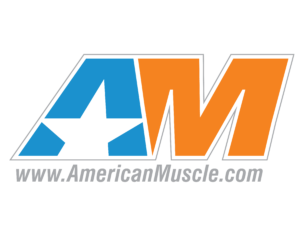 |  |  |



